Diploma in Business Assignment
VerifiedAdded on 2021/06/17
|36
|10364
|75
AI Summary
Contribute Materials
Your contribution can guide someone’s learning journey. Share your
documents today.
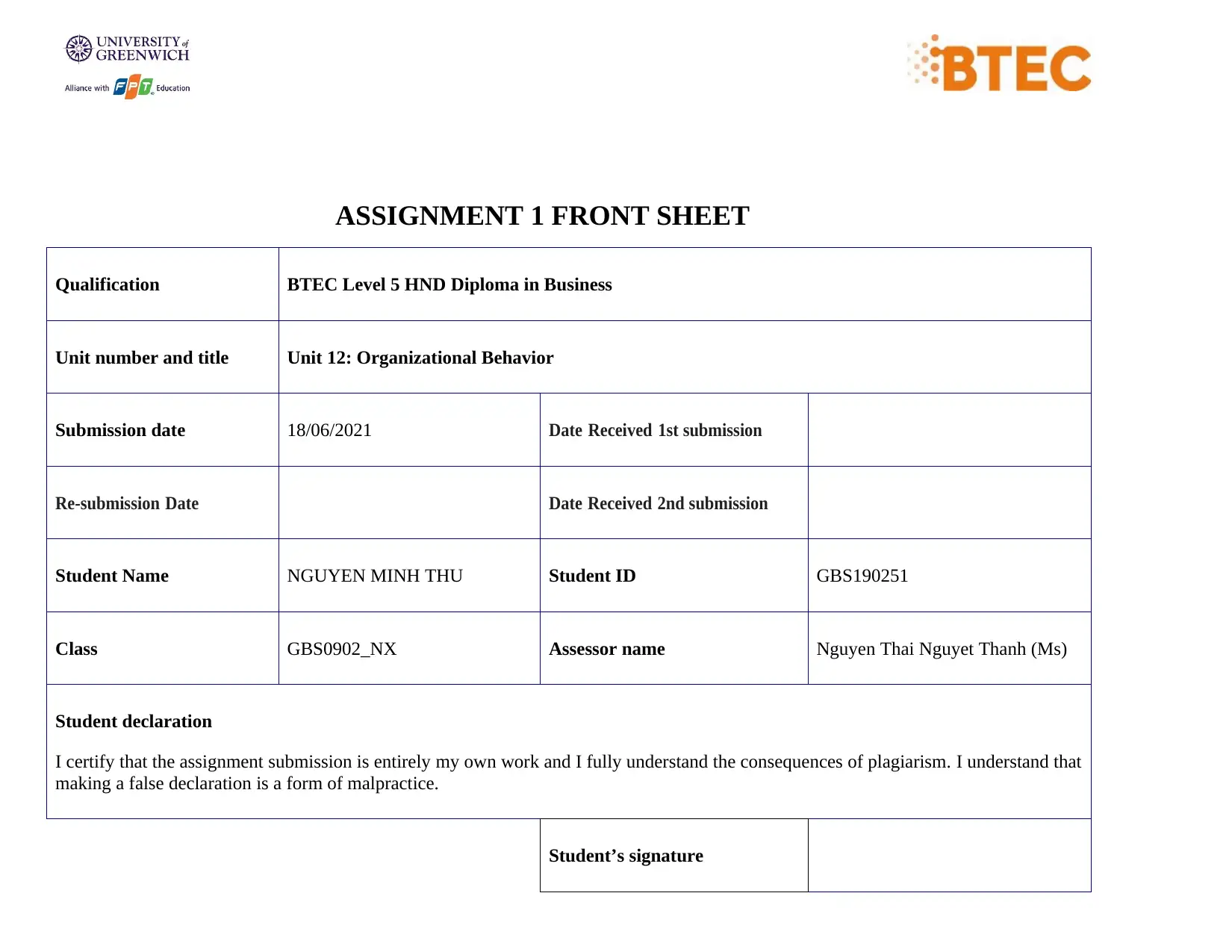
ASSIGNMENT 1 FRONT SHEET
Qualification BTEC Level 5 HND Diploma in Business
Unit number and title Unit 12: Organizational Behavior
Submission date 18/06/2021 Date Received 1st submission
Re-submission Date Date Received 2nd submission
Student Name NGUYEN MINH THU Student ID GBS190251
Class GBS0902_NX Assessor name Nguyen Thai Nguyet Thanh (Ms)
Student declaration
I certify that the assignment submission is entirely my own work and I fully understand the consequences of plagiarism. I understand that
making a false declaration is a form of malpractice.
Student’s signature
Qualification BTEC Level 5 HND Diploma in Business
Unit number and title Unit 12: Organizational Behavior
Submission date 18/06/2021 Date Received 1st submission
Re-submission Date Date Received 2nd submission
Student Name NGUYEN MINH THU Student ID GBS190251
Class GBS0902_NX Assessor name Nguyen Thai Nguyet Thanh (Ms)
Student declaration
I certify that the assignment submission is entirely my own work and I fully understand the consequences of plagiarism. I understand that
making a false declaration is a form of malpractice.
Student’s signature
Secure Best Marks with AI Grader
Need help grading? Try our AI Grader for instant feedback on your assignments.
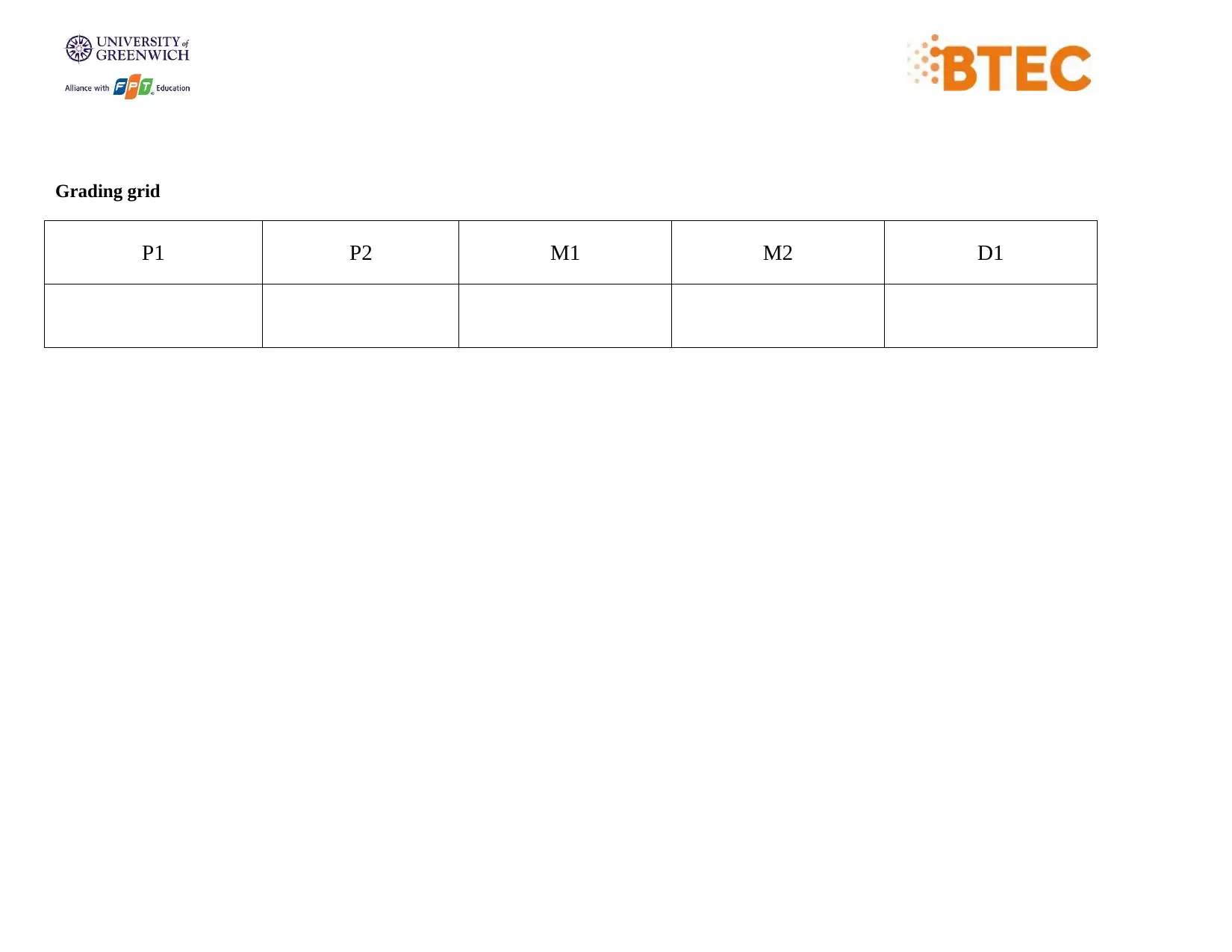
Grading grid
P1 P2 M1 M2 D1
P1 P2 M1 M2 D1
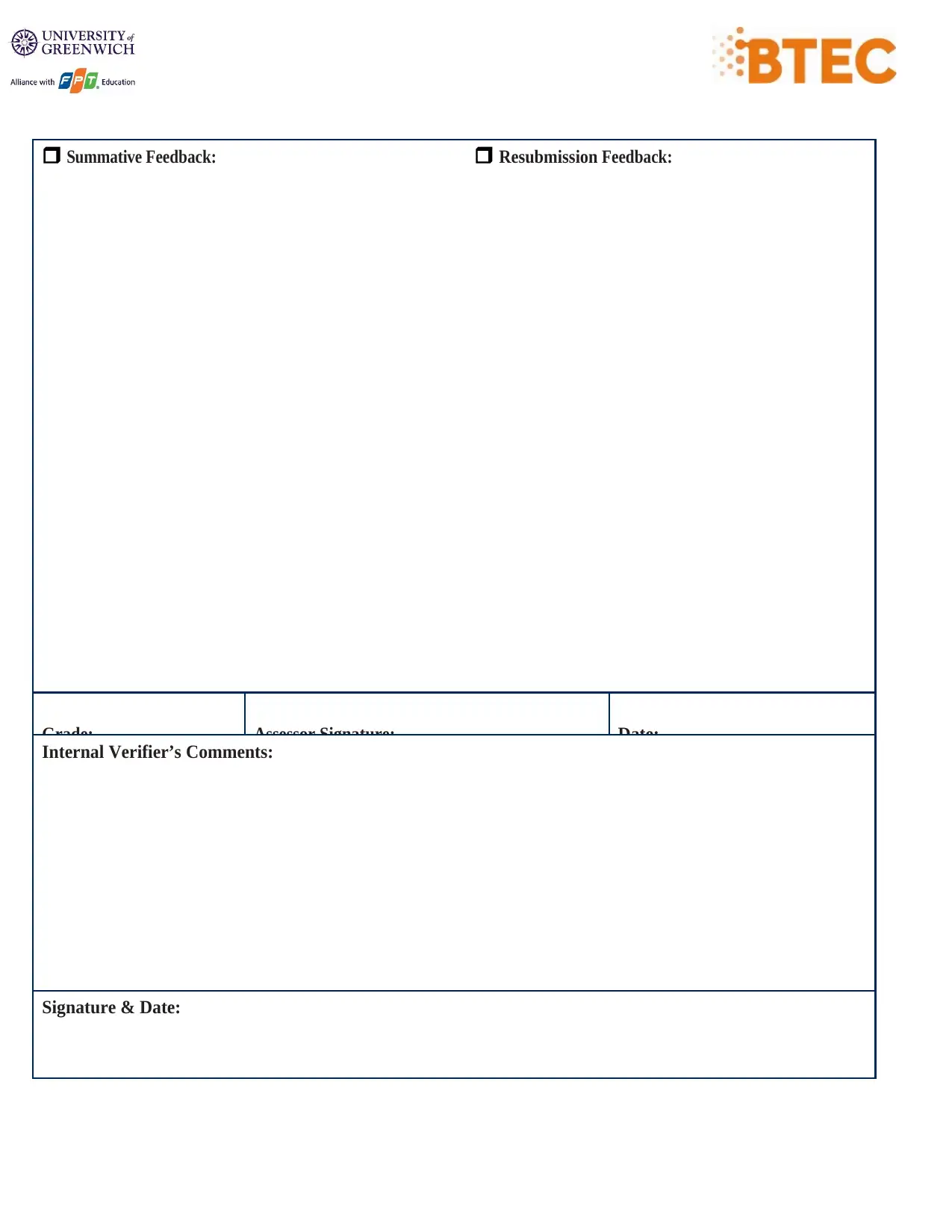
Summative Feedback: Resubmission Feedback:
Grade: Assessor Signature: Date:
Internal Verifier’s Comments:
Signature & Date:
Grade: Assessor Signature: Date:
Internal Verifier’s Comments:
Signature & Date:
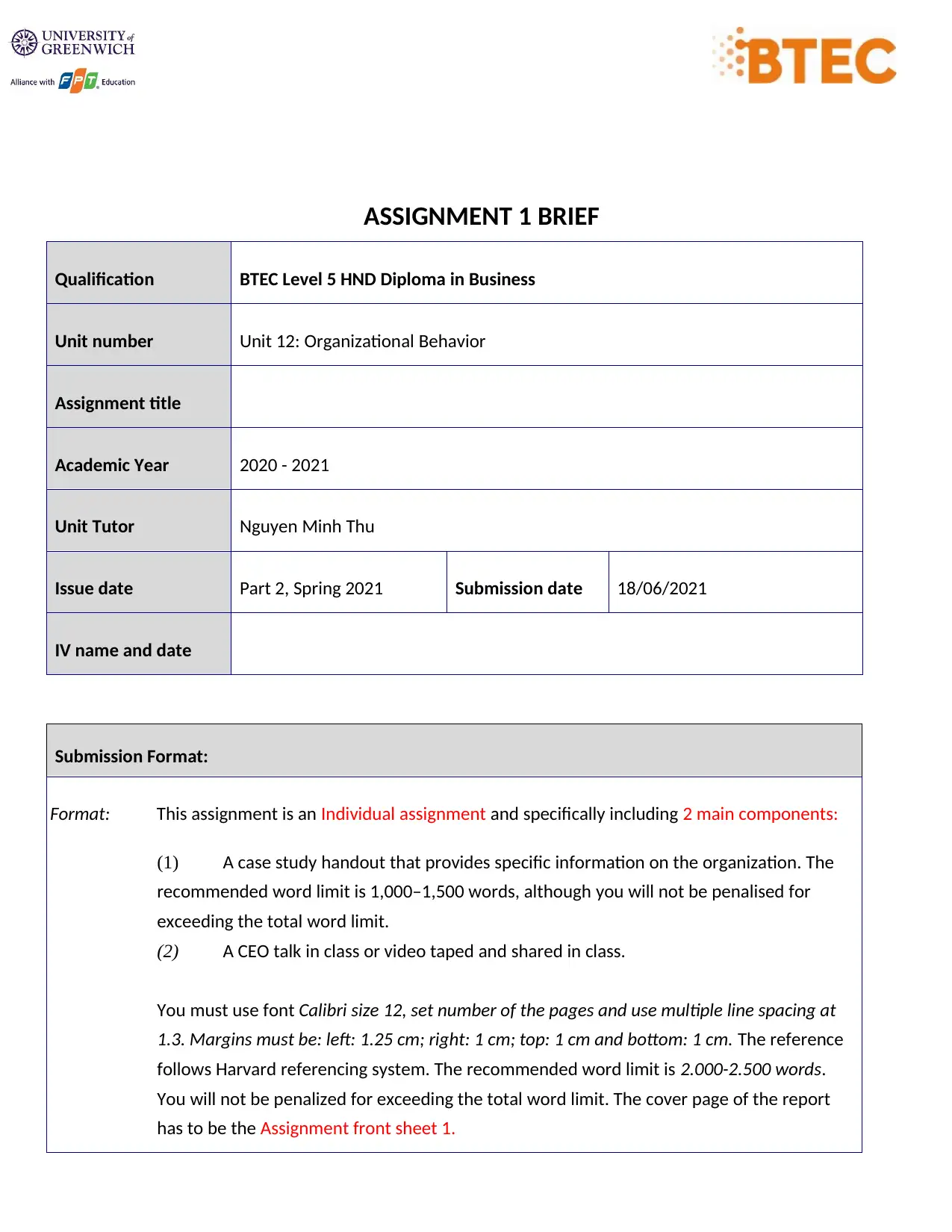
ASSIGNMENT 1 BRIEF
Qualification BTEC Level 5 HND Diploma in Business
Unit number Unit 12: Organizational Behavior
Assignment title
Academic Year 2020 - 2021
Unit Tutor Nguyen Minh Thu
Issue date Part 2, Spring 2021 Submission date 18/06/2021
IV name and date
Submission Format:
Format: This assignment is an Individual assignment and specifically including 2 main components:
(1) A case study handout that provides specific information on the organization. The
recommended word limit is 1,000–1,500 words, although you will not be penalised for
exceeding the total word limit.
(2) A CEO talk in class or video taped and shared in class.
You must use font Calibri size 12, set number of the pages and use multiple line spacing at
1.3. Margins must be: left: 1.25 cm; right: 1 cm; top: 1 cm and bottom: 1 cm. The reference
follows Harvard referencing system. The recommended word limit is 2.000-2.500 words.
You will not be penalized for exceeding the total word limit. The cover page of the report
has to be the Assignment front sheet 1.
Qualification BTEC Level 5 HND Diploma in Business
Unit number Unit 12: Organizational Behavior
Assignment title
Academic Year 2020 - 2021
Unit Tutor Nguyen Minh Thu
Issue date Part 2, Spring 2021 Submission date 18/06/2021
IV name and date
Submission Format:
Format: This assignment is an Individual assignment and specifically including 2 main components:
(1) A case study handout that provides specific information on the organization. The
recommended word limit is 1,000–1,500 words, although you will not be penalised for
exceeding the total word limit.
(2) A CEO talk in class or video taped and shared in class.
You must use font Calibri size 12, set number of the pages and use multiple line spacing at
1.3. Margins must be: left: 1.25 cm; right: 1 cm; top: 1 cm and bottom: 1 cm. The reference
follows Harvard referencing system. The recommended word limit is 2.000-2.500 words.
You will not be penalized for exceeding the total word limit. The cover page of the report
has to be the Assignment front sheet 1.
Secure Best Marks with AI Grader
Need help grading? Try our AI Grader for instant feedback on your assignments.
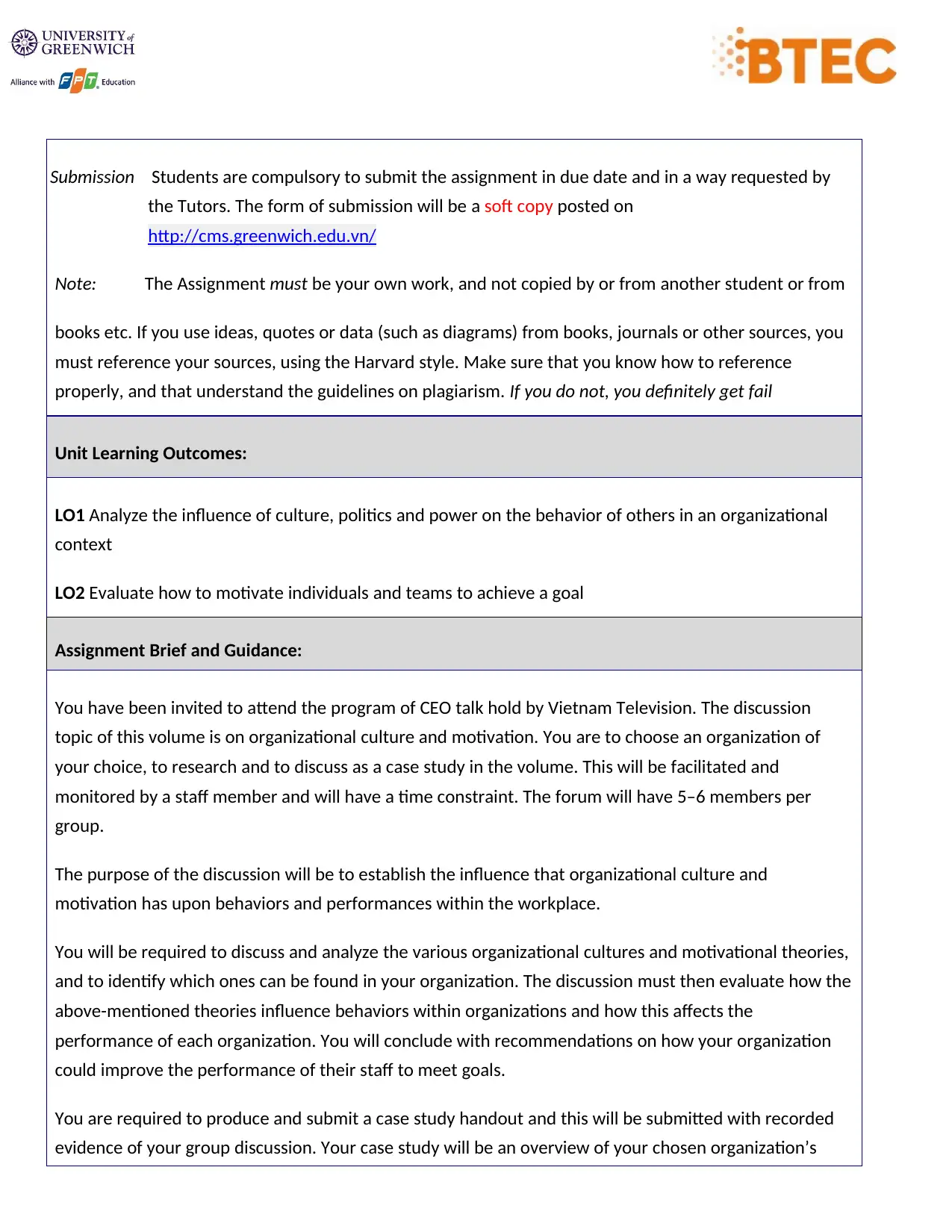
Submission Students are compulsory to submit the assignment in due date and in a way requested by
the Tutors. The form of submission will be a soft copy posted on
http://cms.greenwich.edu.vn/
Note: The Assignment must be your own work, and not copied by or from another student or from
books etc. If you use ideas, quotes or data (such as diagrams) from books, journals or other sources, you
must reference your sources, using the Harvard style. Make sure that you know how to reference
properly, and that understand the guidelines on plagiarism. If you do not, you definitely get fail
Unit Learning Outcomes:
LO1 Analyze the influence of culture, politics and power on the behavior of others in an organizational
context
LO2 Evaluate how to motivate individuals and teams to achieve a goal
Assignment Brief and Guidance:
You have been invited to attend the program of CEO talk hold by Vietnam Television. The discussion
topic of this volume is on organizational culture and motivation. You are to choose an organization of
your choice, to research and to discuss as a case study in the volume. This will be facilitated and
monitored by a staff member and will have a time constraint. The forum will have 5–6 members per
group.
The purpose of the discussion will be to establish the influence that organizational culture and
motivation has upon behaviors and performances within the workplace.
You will be required to discuss and analyze the various organizational cultures and motivational theories,
and to identify which ones can be found in your organization. The discussion must then evaluate how the
above-mentioned theories influence behaviors within organizations and how this affects the
performance of each organization. You will conclude with recommendations on how your organization
could improve the performance of their staff to meet goals.
You are required to produce and submit a case study handout and this will be submitted with recorded
evidence of your group discussion. Your case study will be an overview of your chosen organization’s
the Tutors. The form of submission will be a soft copy posted on
http://cms.greenwich.edu.vn/
Note: The Assignment must be your own work, and not copied by or from another student or from
books etc. If you use ideas, quotes or data (such as diagrams) from books, journals or other sources, you
must reference your sources, using the Harvard style. Make sure that you know how to reference
properly, and that understand the guidelines on plagiarism. If you do not, you definitely get fail
Unit Learning Outcomes:
LO1 Analyze the influence of culture, politics and power on the behavior of others in an organizational
context
LO2 Evaluate how to motivate individuals and teams to achieve a goal
Assignment Brief and Guidance:
You have been invited to attend the program of CEO talk hold by Vietnam Television. The discussion
topic of this volume is on organizational culture and motivation. You are to choose an organization of
your choice, to research and to discuss as a case study in the volume. This will be facilitated and
monitored by a staff member and will have a time constraint. The forum will have 5–6 members per
group.
The purpose of the discussion will be to establish the influence that organizational culture and
motivation has upon behaviors and performances within the workplace.
You will be required to discuss and analyze the various organizational cultures and motivational theories,
and to identify which ones can be found in your organization. The discussion must then evaluate how the
above-mentioned theories influence behaviors within organizations and how this affects the
performance of each organization. You will conclude with recommendations on how your organization
could improve the performance of their staff to meet goals.
You are required to produce and submit a case study handout and this will be submitted with recorded
evidence of your group discussion. Your case study will be an overview of your chosen organization’s
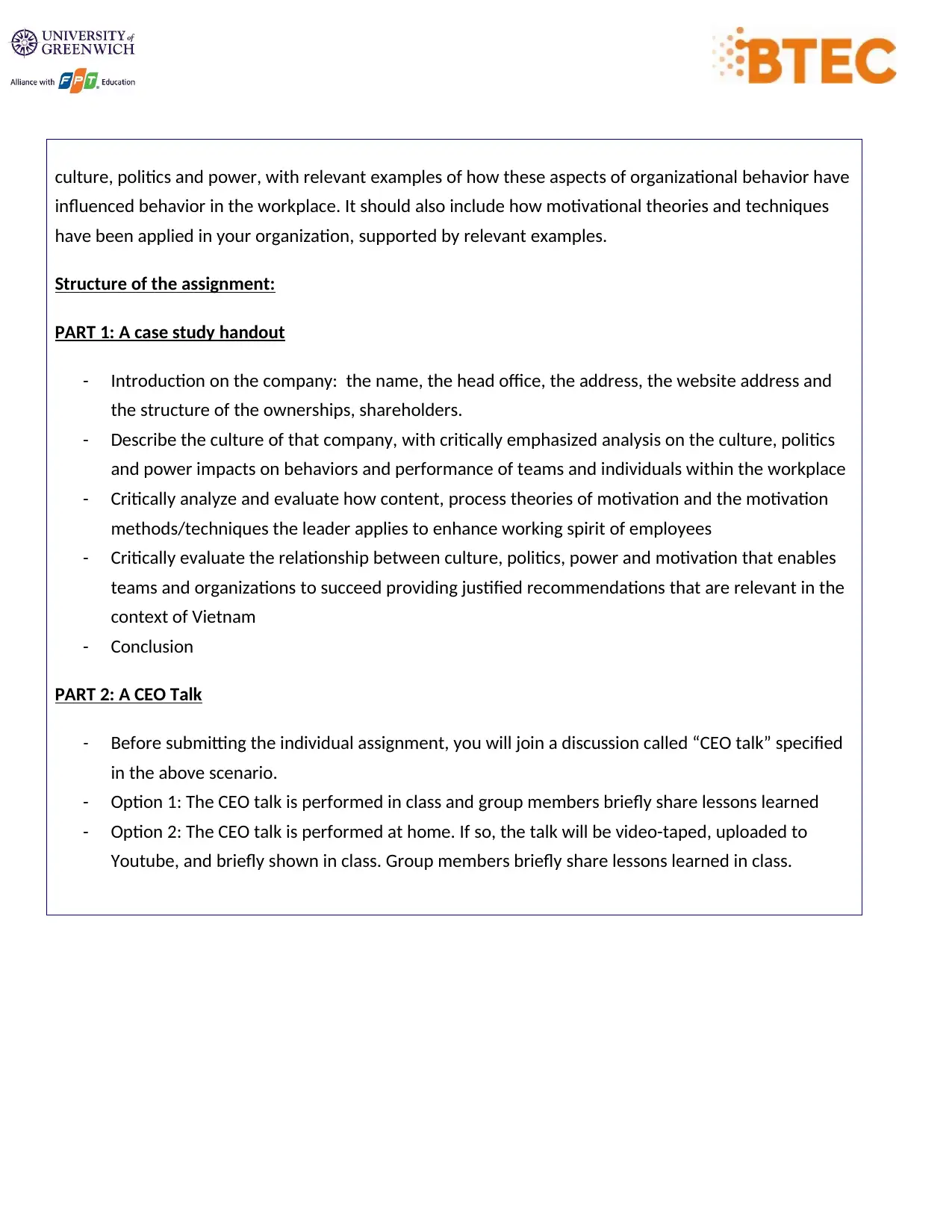
culture, politics and power, with relevant examples of how these aspects of organizational behavior have
influenced behavior in the workplace. It should also include how motivational theories and techniques
have been applied in your organization, supported by relevant examples.
Structure of the assignment:
PART 1: A case study handout
- Introduction on the company: the name, the head office, the address, the website address and
the structure of the ownerships, shareholders.
- Describe the culture of that company, with critically emphasized analysis on the culture, politics
and power impacts on behaviors and performance of teams and individuals within the workplace
- Critically analyze and evaluate how content, process theories of motivation and the motivation
methods/techniques the leader applies to enhance working spirit of employees
- Critically evaluate the relationship between culture, politics, power and motivation that enables
teams and organizations to succeed providing justified recommendations that are relevant in the
context of Vietnam
- Conclusion
PART 2: A CEO Talk
- Before submitting the individual assignment, you will join a discussion called “CEO talk” specified
in the above scenario.
- Option 1: The CEO talk is performed in class and group members briefly share lessons learned
- Option 2: The CEO talk is performed at home. If so, the talk will be video-taped, uploaded to
Youtube, and briefly shown in class. Group members briefly share lessons learned in class.
influenced behavior in the workplace. It should also include how motivational theories and techniques
have been applied in your organization, supported by relevant examples.
Structure of the assignment:
PART 1: A case study handout
- Introduction on the company: the name, the head office, the address, the website address and
the structure of the ownerships, shareholders.
- Describe the culture of that company, with critically emphasized analysis on the culture, politics
and power impacts on behaviors and performance of teams and individuals within the workplace
- Critically analyze and evaluate how content, process theories of motivation and the motivation
methods/techniques the leader applies to enhance working spirit of employees
- Critically evaluate the relationship between culture, politics, power and motivation that enables
teams and organizations to succeed providing justified recommendations that are relevant in the
context of Vietnam
- Conclusion
PART 2: A CEO Talk
- Before submitting the individual assignment, you will join a discussion called “CEO talk” specified
in the above scenario.
- Option 1: The CEO talk is performed in class and group members briefly share lessons learned
- Option 2: The CEO talk is performed at home. If so, the talk will be video-taped, uploaded to
Youtube, and briefly shown in class. Group members briefly share lessons learned in class.

Grading criteria
LO1 Analyze the influence of culture, politics and power on the
behavior of others in an organizational context
D1 Critically evaluate the
relationship between culture,
politics, power and motivation
that enables teams and
organizations to succeed
providing justified
recommendations that are
relevant in the context of
Vietnam
P1 Analyze how an organization’s
culture, politics and power
influence individual and team
behavior and performance.
M1 Critically analyze how the
culture, politics and power of an
organization can influence
individual and team behavior and
performance.
LO2 Evaluate how to motivate individuals and teams to achieve a goal
P2 Evaluate how content and
process theories of motivation
and motivational techniques
enable effective achievement of
goals in an organizational context.
M2 Critically evaluate how to
influence the behavior of others
through the effective application
of behavioral motivational
theories, concepts and models
LO1 Analyze the influence of culture, politics and power on the
behavior of others in an organizational context
D1 Critically evaluate the
relationship between culture,
politics, power and motivation
that enables teams and
organizations to succeed
providing justified
recommendations that are
relevant in the context of
Vietnam
P1 Analyze how an organization’s
culture, politics and power
influence individual and team
behavior and performance.
M1 Critically analyze how the
culture, politics and power of an
organization can influence
individual and team behavior and
performance.
LO2 Evaluate how to motivate individuals and teams to achieve a goal
P2 Evaluate how content and
process theories of motivation
and motivational techniques
enable effective achievement of
goals in an organizational context.
M2 Critically evaluate how to
influence the behavior of others
through the effective application
of behavioral motivational
theories, concepts and models
Paraphrase This Document
Need a fresh take? Get an instant paraphrase of this document with our AI Paraphraser
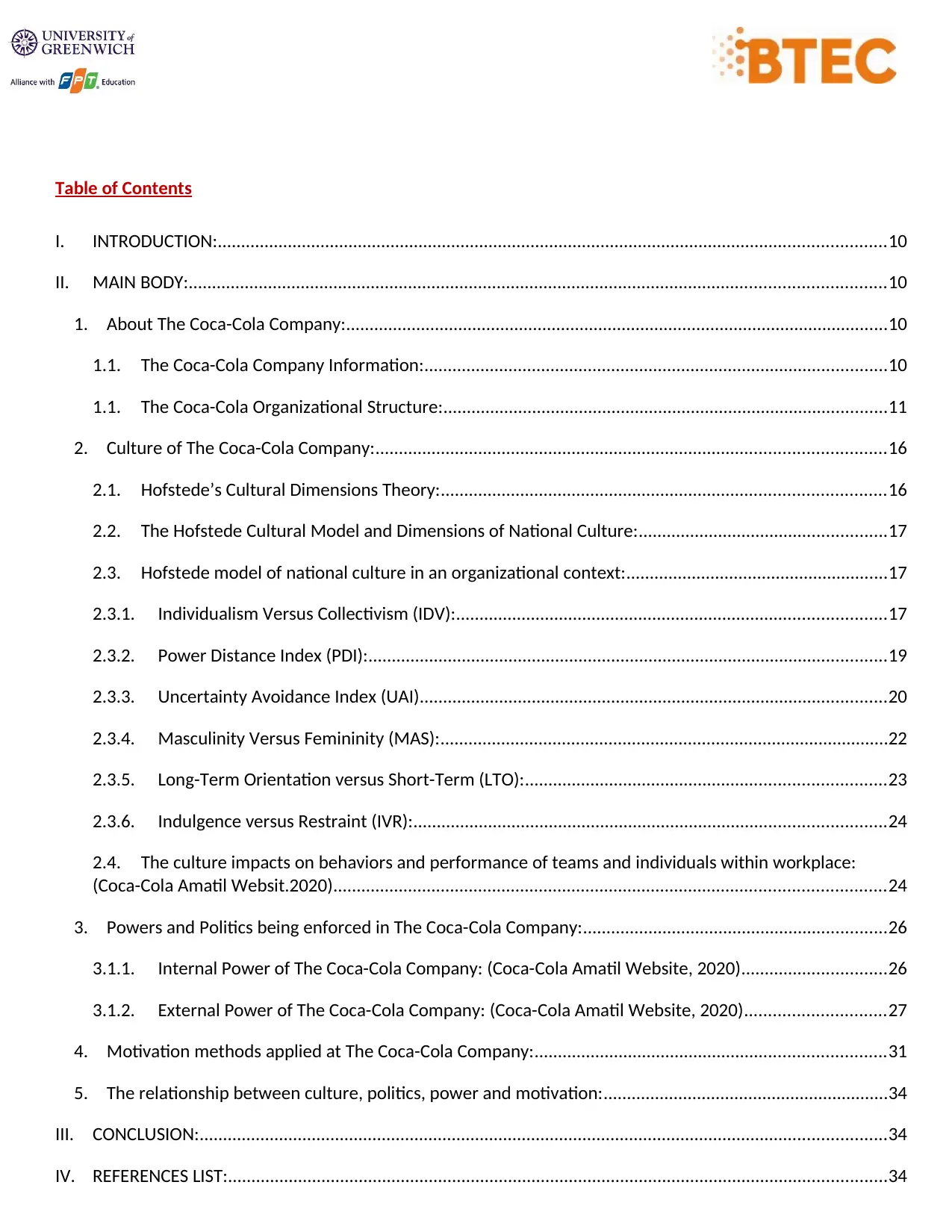
Table of Contents
I. INTRODUCTION:...............................................................................................................................................10
II. MAIN BODY:.....................................................................................................................................................10
1. About The Coca-Cola Company:....................................................................................................................10
1.1. The Coca-Cola Company Information:...................................................................................................10
1.1. The Coca-Cola Organizational Structure:...............................................................................................11
2. Culture of The Coca-Cola Company:.............................................................................................................16
2.1. Hofstede’s Cultural Dimensions Theory:...............................................................................................16
2.2. The Hofstede Cultural Model and Dimensions of National Culture:.....................................................17
2.3. Hofstede model of national culture in an organizational context:........................................................17
2.3.1. Individualism Versus Collectivism (IDV):............................................................................................17
2.3.2. Power Distance Index (PDI):...............................................................................................................19
2.3.3. Uncertainty Avoidance Index (UAI)....................................................................................................20
2.3.4. Masculinity Versus Femininity (MAS):................................................................................................22
2.3.5. Long-Term Orientation versus Short-Term (LTO):.............................................................................23
2.3.6. Indulgence versus Restraint (IVR):.....................................................................................................24
2.4. The culture impacts on behaviors and performance of teams and individuals within workplace:
(Coca-Cola Amatil Websit.2020)......................................................................................................................24
3. Powers and Politics being enforced in The Coca-Cola Company:.................................................................26
3.1.1. Internal Power of The Coca-Cola Company: (Coca-Cola Amatil Website, 2020)...............................26
3.1.2. External Power of The Coca-Cola Company: (Coca-Cola Amatil Website, 2020)..............................27
4. Motivation methods applied at The Coca-Cola Company:...........................................................................31
5. The relationship between culture, politics, power and motivation:.............................................................34
III. CONCLUSION:...................................................................................................................................................34
IV. REFERENCES LIST:.............................................................................................................................................34
I. INTRODUCTION:...............................................................................................................................................10
II. MAIN BODY:.....................................................................................................................................................10
1. About The Coca-Cola Company:....................................................................................................................10
1.1. The Coca-Cola Company Information:...................................................................................................10
1.1. The Coca-Cola Organizational Structure:...............................................................................................11
2. Culture of The Coca-Cola Company:.............................................................................................................16
2.1. Hofstede’s Cultural Dimensions Theory:...............................................................................................16
2.2. The Hofstede Cultural Model and Dimensions of National Culture:.....................................................17
2.3. Hofstede model of national culture in an organizational context:........................................................17
2.3.1. Individualism Versus Collectivism (IDV):............................................................................................17
2.3.2. Power Distance Index (PDI):...............................................................................................................19
2.3.3. Uncertainty Avoidance Index (UAI)....................................................................................................20
2.3.4. Masculinity Versus Femininity (MAS):................................................................................................22
2.3.5. Long-Term Orientation versus Short-Term (LTO):.............................................................................23
2.3.6. Indulgence versus Restraint (IVR):.....................................................................................................24
2.4. The culture impacts on behaviors and performance of teams and individuals within workplace:
(Coca-Cola Amatil Websit.2020)......................................................................................................................24
3. Powers and Politics being enforced in The Coca-Cola Company:.................................................................26
3.1.1. Internal Power of The Coca-Cola Company: (Coca-Cola Amatil Website, 2020)...............................26
3.1.2. External Power of The Coca-Cola Company: (Coca-Cola Amatil Website, 2020)..............................27
4. Motivation methods applied at The Coca-Cola Company:...........................................................................31
5. The relationship between culture, politics, power and motivation:.............................................................34
III. CONCLUSION:...................................................................................................................................................34
IV. REFERENCES LIST:.............................................................................................................................................34
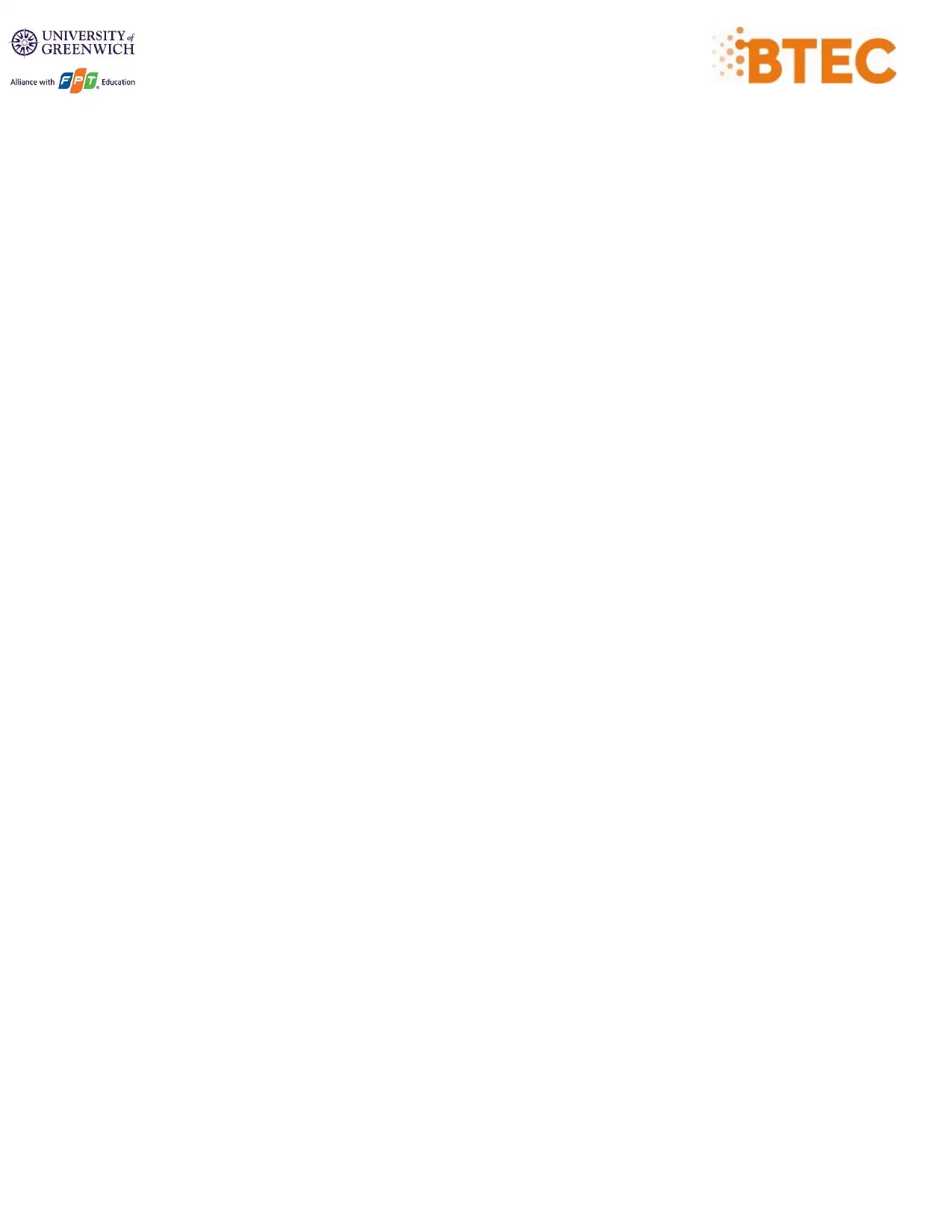
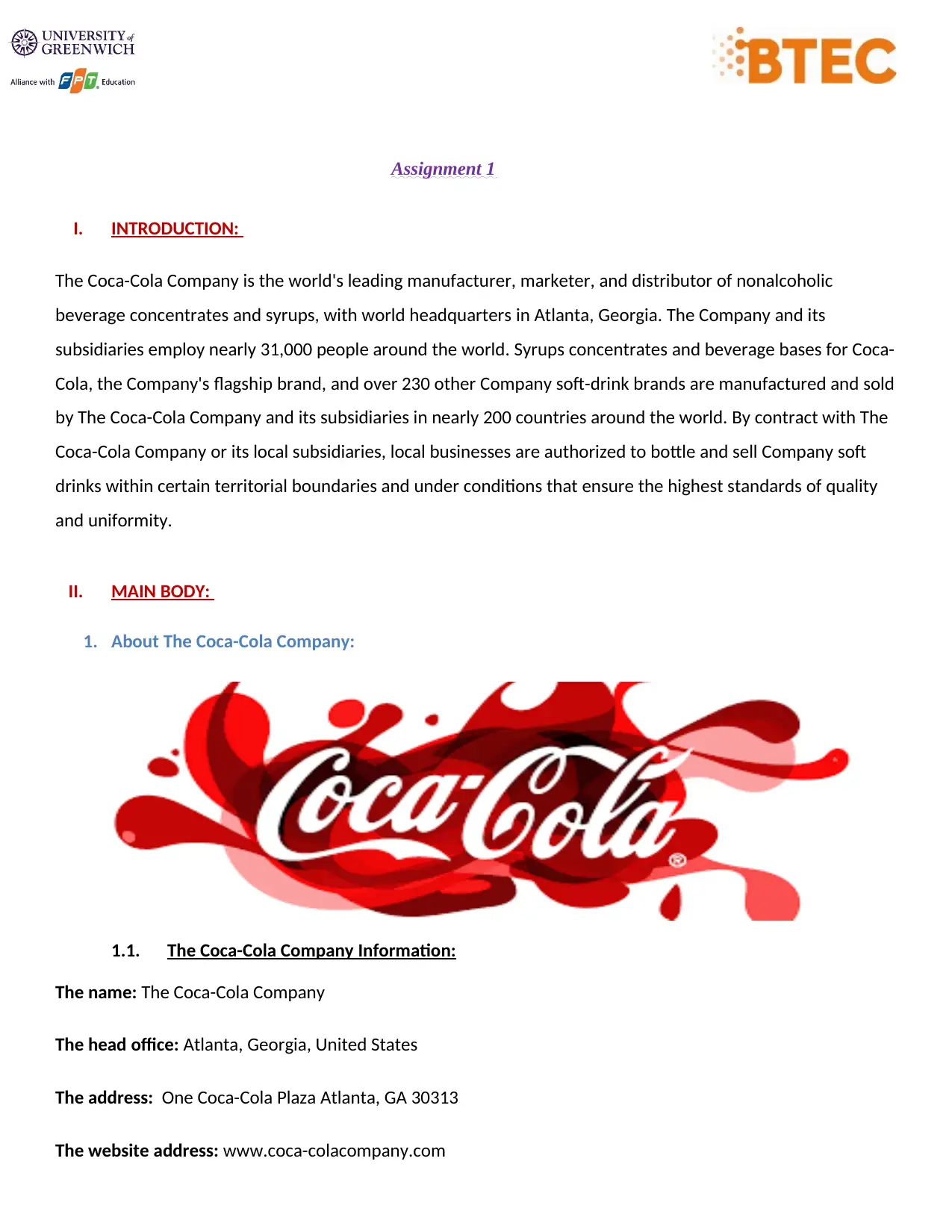
Assignment 1
I. INTRODUCTION:
The Coca-Cola Company is the world's leading manufacturer, marketer, and distributor of nonalcoholic
beverage concentrates and syrups, with world headquarters in Atlanta, Georgia. The Company and its
subsidiaries employ nearly 31,000 people around the world. Syrups concentrates and beverage bases for Coca-
Cola, the Company's flagship brand, and over 230 other Company soft-drink brands are manufactured and sold
by The Coca-Cola Company and its subsidiaries in nearly 200 countries around the world. By contract with The
Coca-Cola Company or its local subsidiaries, local businesses are authorized to bottle and sell Company soft
drinks within certain territorial boundaries and under conditions that ensure the highest standards of quality
and uniformity.
II. MAIN BODY:
1. About The Coca-Cola Company:
1.1. The Coca-Cola Company Information:
The name: The Coca-Cola Company
The head office: Atlanta, Georgia, United States
The address: One Coca-Cola Plaza Atlanta, GA 30313
The website address: www.coca-colacompany.com
I. INTRODUCTION:
The Coca-Cola Company is the world's leading manufacturer, marketer, and distributor of nonalcoholic
beverage concentrates and syrups, with world headquarters in Atlanta, Georgia. The Company and its
subsidiaries employ nearly 31,000 people around the world. Syrups concentrates and beverage bases for Coca-
Cola, the Company's flagship brand, and over 230 other Company soft-drink brands are manufactured and sold
by The Coca-Cola Company and its subsidiaries in nearly 200 countries around the world. By contract with The
Coca-Cola Company or its local subsidiaries, local businesses are authorized to bottle and sell Company soft
drinks within certain territorial boundaries and under conditions that ensure the highest standards of quality
and uniformity.
II. MAIN BODY:
1. About The Coca-Cola Company:
1.1. The Coca-Cola Company Information:
The name: The Coca-Cola Company
The head office: Atlanta, Georgia, United States
The address: One Coca-Cola Plaza Atlanta, GA 30313
The website address: www.coca-colacompany.com
Secure Best Marks with AI Grader
Need help grading? Try our AI Grader for instant feedback on your assignments.
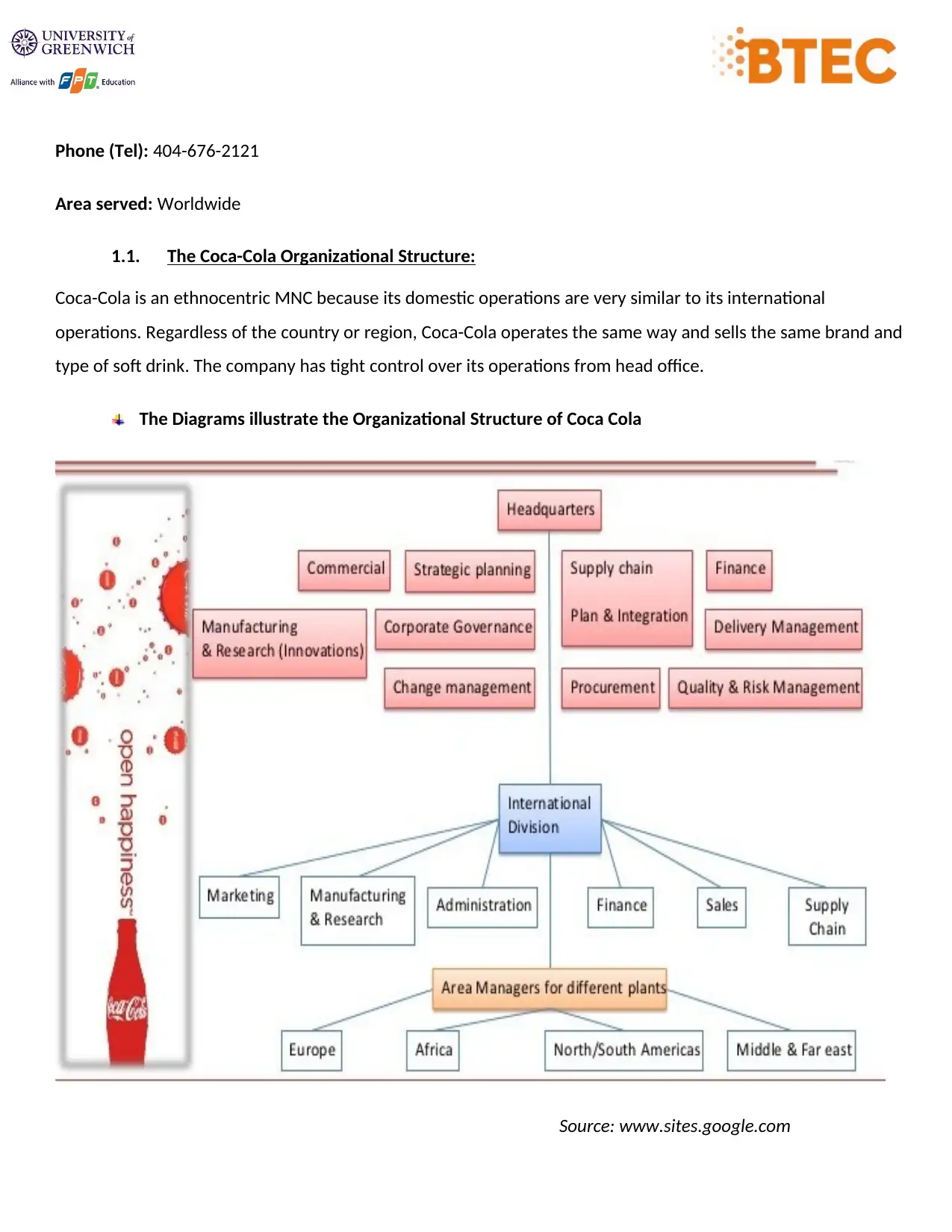
Phone (Tel): 404-676-2121
Area served: Worldwide
1.1. The Coca-Cola Organizational Structure:
Coca-Cola is an ethnocentric MNC because its domestic operations are very similar to its international
operations. Regardless of the country or region, Coca-Cola operates the same way and sells the same brand and
type of soft drink. The company has tight control over its operations from head office.
The Diagrams illustrate the Organizational Structure of Coca Cola
Source: www.sites.google.com
Area served: Worldwide
1.1. The Coca-Cola Organizational Structure:
Coca-Cola is an ethnocentric MNC because its domestic operations are very similar to its international
operations. Regardless of the country or region, Coca-Cola operates the same way and sells the same brand and
type of soft drink. The company has tight control over its operations from head office.
The Diagrams illustrate the Organizational Structure of Coca Cola
Source: www.sites.google.com
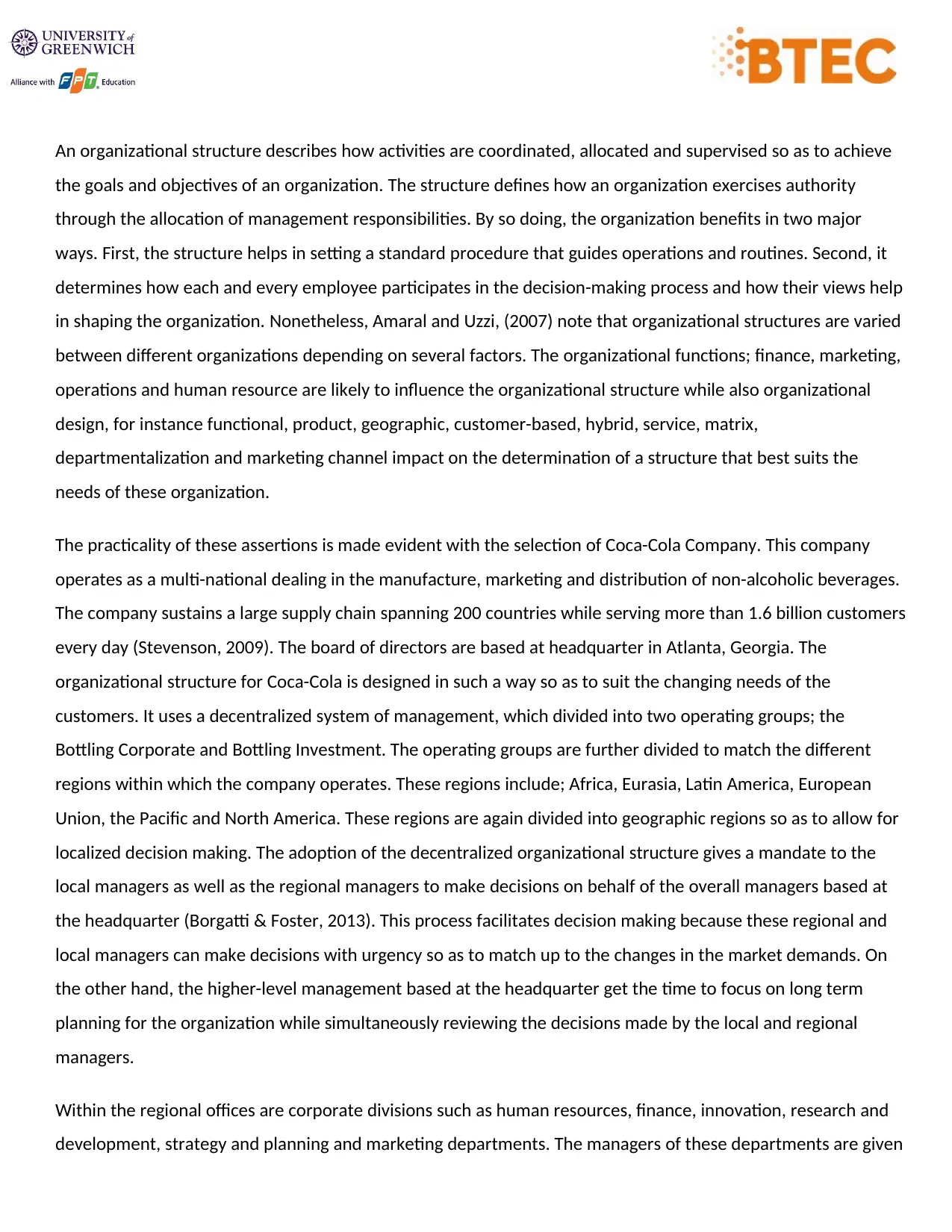
An organizational structure describes how activities are coordinated, allocated and supervised so as to achieve
the goals and objectives of an organization. The structure defines how an organization exercises authority
through the allocation of management responsibilities. By so doing, the organization benefits in two major
ways. First, the structure helps in setting a standard procedure that guides operations and routines. Second, it
determines how each and every employee participates in the decision-making process and how their views help
in shaping the organization. Nonetheless, Amaral and Uzzi, (2007) note that organizational structures are varied
between different organizations depending on several factors. The organizational functions; finance, marketing,
operations and human resource are likely to influence the organizational structure while also organizational
design, for instance functional, product, geographic, customer-based, hybrid, service, matrix,
departmentalization and marketing channel impact on the determination of a structure that best suits the
needs of these organization.
The practicality of these assertions is made evident with the selection of Coca-Cola Company. This company
operates as a multi-national dealing in the manufacture, marketing and distribution of non-alcoholic beverages.
The company sustains a large supply chain spanning 200 countries while serving more than 1.6 billion customers
every day (Stevenson, 2009). The board of directors are based at headquarter in Atlanta, Georgia. The
organizational structure for Coca-Cola is designed in such a way so as to suit the changing needs of the
customers. It uses a decentralized system of management, which divided into two operating groups; the
Bottling Corporate and Bottling Investment. The operating groups are further divided to match the different
regions within which the company operates. These regions include; Africa, Eurasia, Latin America, European
Union, the Pacific and North America. These regions are again divided into geographic regions so as to allow for
localized decision making. The adoption of the decentralized organizational structure gives a mandate to the
local managers as well as the regional managers to make decisions on behalf of the overall managers based at
the headquarter (Borgatti & Foster, 2013). This process facilitates decision making because these regional and
local managers can make decisions with urgency so as to match up to the changes in the market demands. On
the other hand, the higher-level management based at the headquarter get the time to focus on long term
planning for the organization while simultaneously reviewing the decisions made by the local and regional
managers.
Within the regional offices are corporate divisions such as human resources, finance, innovation, research and
development, strategy and planning and marketing departments. The managers of these departments are given
the goals and objectives of an organization. The structure defines how an organization exercises authority
through the allocation of management responsibilities. By so doing, the organization benefits in two major
ways. First, the structure helps in setting a standard procedure that guides operations and routines. Second, it
determines how each and every employee participates in the decision-making process and how their views help
in shaping the organization. Nonetheless, Amaral and Uzzi, (2007) note that organizational structures are varied
between different organizations depending on several factors. The organizational functions; finance, marketing,
operations and human resource are likely to influence the organizational structure while also organizational
design, for instance functional, product, geographic, customer-based, hybrid, service, matrix,
departmentalization and marketing channel impact on the determination of a structure that best suits the
needs of these organization.
The practicality of these assertions is made evident with the selection of Coca-Cola Company. This company
operates as a multi-national dealing in the manufacture, marketing and distribution of non-alcoholic beverages.
The company sustains a large supply chain spanning 200 countries while serving more than 1.6 billion customers
every day (Stevenson, 2009). The board of directors are based at headquarter in Atlanta, Georgia. The
organizational structure for Coca-Cola is designed in such a way so as to suit the changing needs of the
customers. It uses a decentralized system of management, which divided into two operating groups; the
Bottling Corporate and Bottling Investment. The operating groups are further divided to match the different
regions within which the company operates. These regions include; Africa, Eurasia, Latin America, European
Union, the Pacific and North America. These regions are again divided into geographic regions so as to allow for
localized decision making. The adoption of the decentralized organizational structure gives a mandate to the
local managers as well as the regional managers to make decisions on behalf of the overall managers based at
the headquarter (Borgatti & Foster, 2013). This process facilitates decision making because these regional and
local managers can make decisions with urgency so as to match up to the changes in the market demands. On
the other hand, the higher-level management based at the headquarter get the time to focus on long term
planning for the organization while simultaneously reviewing the decisions made by the local and regional
managers.
Within the regional offices are corporate divisions such as human resources, finance, innovation, research and
development, strategy and planning and marketing departments. The managers of these departments are given
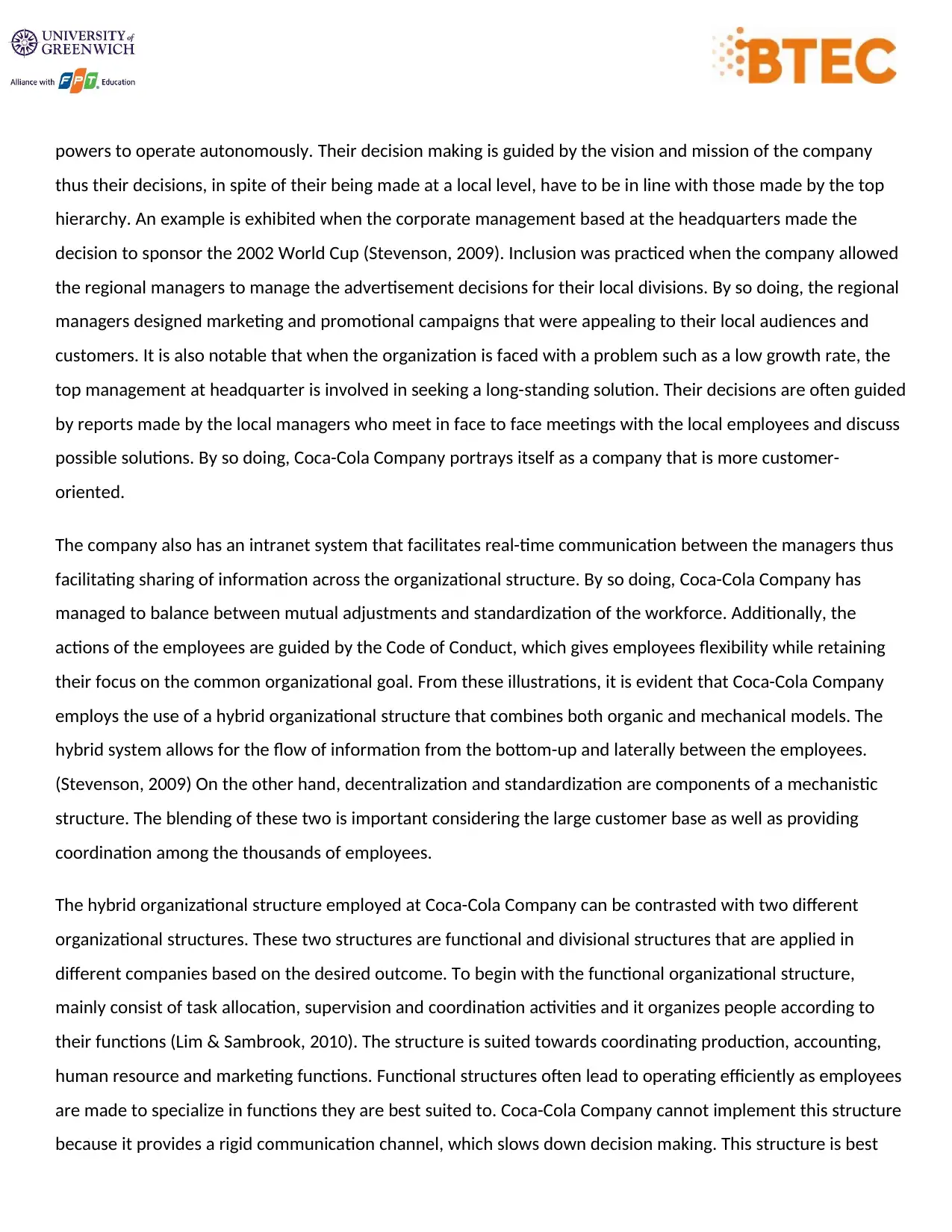
powers to operate autonomously. Their decision making is guided by the vision and mission of the company
thus their decisions, in spite of their being made at a local level, have to be in line with those made by the top
hierarchy. An example is exhibited when the corporate management based at the headquarters made the
decision to sponsor the 2002 World Cup (Stevenson, 2009). Inclusion was practiced when the company allowed
the regional managers to manage the advertisement decisions for their local divisions. By so doing, the regional
managers designed marketing and promotional campaigns that were appealing to their local audiences and
customers. It is also notable that when the organization is faced with a problem such as a low growth rate, the
top management at headquarter is involved in seeking a long-standing solution. Their decisions are often guided
by reports made by the local managers who meet in face to face meetings with the local employees and discuss
possible solutions. By so doing, Coca-Cola Company portrays itself as a company that is more customer-
oriented.
The company also has an intranet system that facilitates real-time communication between the managers thus
facilitating sharing of information across the organizational structure. By so doing, Coca-Cola Company has
managed to balance between mutual adjustments and standardization of the workforce. Additionally, the
actions of the employees are guided by the Code of Conduct, which gives employees flexibility while retaining
their focus on the common organizational goal. From these illustrations, it is evident that Coca-Cola Company
employs the use of a hybrid organizational structure that combines both organic and mechanical models. The
hybrid system allows for the flow of information from the bottom-up and laterally between the employees.
(Stevenson, 2009) On the other hand, decentralization and standardization are components of a mechanistic
structure. The blending of these two is important considering the large customer base as well as providing
coordination among the thousands of employees.
The hybrid organizational structure employed at Coca-Cola Company can be contrasted with two different
organizational structures. These two structures are functional and divisional structures that are applied in
different companies based on the desired outcome. To begin with the functional organizational structure,
mainly consist of task allocation, supervision and coordination activities and it organizes people according to
their functions (Lim & Sambrook, 2010). The structure is suited towards coordinating production, accounting,
human resource and marketing functions. Functional structures often lead to operating efficiently as employees
are made to specialize in functions they are best suited to. Coca-Cola Company cannot implement this structure
because it provides a rigid communication channel, which slows down decision making. This structure is best
thus their decisions, in spite of their being made at a local level, have to be in line with those made by the top
hierarchy. An example is exhibited when the corporate management based at the headquarters made the
decision to sponsor the 2002 World Cup (Stevenson, 2009). Inclusion was practiced when the company allowed
the regional managers to manage the advertisement decisions for their local divisions. By so doing, the regional
managers designed marketing and promotional campaigns that were appealing to their local audiences and
customers. It is also notable that when the organization is faced with a problem such as a low growth rate, the
top management at headquarter is involved in seeking a long-standing solution. Their decisions are often guided
by reports made by the local managers who meet in face to face meetings with the local employees and discuss
possible solutions. By so doing, Coca-Cola Company portrays itself as a company that is more customer-
oriented.
The company also has an intranet system that facilitates real-time communication between the managers thus
facilitating sharing of information across the organizational structure. By so doing, Coca-Cola Company has
managed to balance between mutual adjustments and standardization of the workforce. Additionally, the
actions of the employees are guided by the Code of Conduct, which gives employees flexibility while retaining
their focus on the common organizational goal. From these illustrations, it is evident that Coca-Cola Company
employs the use of a hybrid organizational structure that combines both organic and mechanical models. The
hybrid system allows for the flow of information from the bottom-up and laterally between the employees.
(Stevenson, 2009) On the other hand, decentralization and standardization are components of a mechanistic
structure. The blending of these two is important considering the large customer base as well as providing
coordination among the thousands of employees.
The hybrid organizational structure employed at Coca-Cola Company can be contrasted with two different
organizational structures. These two structures are functional and divisional structures that are applied in
different companies based on the desired outcome. To begin with the functional organizational structure,
mainly consist of task allocation, supervision and coordination activities and it organizes people according to
their functions (Lim & Sambrook, 2010). The structure is suited towards coordinating production, accounting,
human resource and marketing functions. Functional structures often lead to operating efficiently as employees
are made to specialize in functions they are best suited to. Coca-Cola Company cannot implement this structure
because it provides a rigid communication channel, which slows down decision making. This structure is best
Paraphrase This Document
Need a fresh take? Get an instant paraphrase of this document with our AI Paraphraser

suited to small organizations that produce standardized goods. Comparing the structural organization structure
to the hybrid structure used at Coca-Cola shows that a combination of organic and mechanic structure could be
better suited towards managing multi-national organizations because of the increased communication between
the various departments, the employees and the top-most management. In contrast, whereas functional
structure could result in disagreements for large organizations, it could enhance coordination of employees
when applied to small firms.
The First Level of Hierarchy Is Occupied For The Board - Coca Cola Matrix Structure
Source: www.pngkey.com
The second organizational structure that will be compared and contrasted against the hybrid structure used at
Coca-Cola Company is the matrix organizational structure (Burt, 2012). This structure divides the employees
based on the products of the firm as well as their functions. A matrix structure combines teams of employees
rather than individuals as seen in the functional structure. By so doing, the organization takes advantage of
group work and exploits their strengths while making up for their individual weaknesses that are common
among functional and decentralized structures. The matrix structure provides a pure organizational structure
that ensures control while at the same time regulating the activities of the employees (Jacobides, 2007). It is
to the hybrid structure used at Coca-Cola shows that a combination of organic and mechanic structure could be
better suited towards managing multi-national organizations because of the increased communication between
the various departments, the employees and the top-most management. In contrast, whereas functional
structure could result in disagreements for large organizations, it could enhance coordination of employees
when applied to small firms.
The First Level of Hierarchy Is Occupied For The Board - Coca Cola Matrix Structure
Source: www.pngkey.com
The second organizational structure that will be compared and contrasted against the hybrid structure used at
Coca-Cola Company is the matrix organizational structure (Burt, 2012). This structure divides the employees
based on the products of the firm as well as their functions. A matrix structure combines teams of employees
rather than individuals as seen in the functional structure. By so doing, the organization takes advantage of
group work and exploits their strengths while making up for their individual weaknesses that are common
among functional and decentralized structures. The matrix structure provides a pure organizational structure
that ensures control while at the same time regulating the activities of the employees (Jacobides, 2007). It is
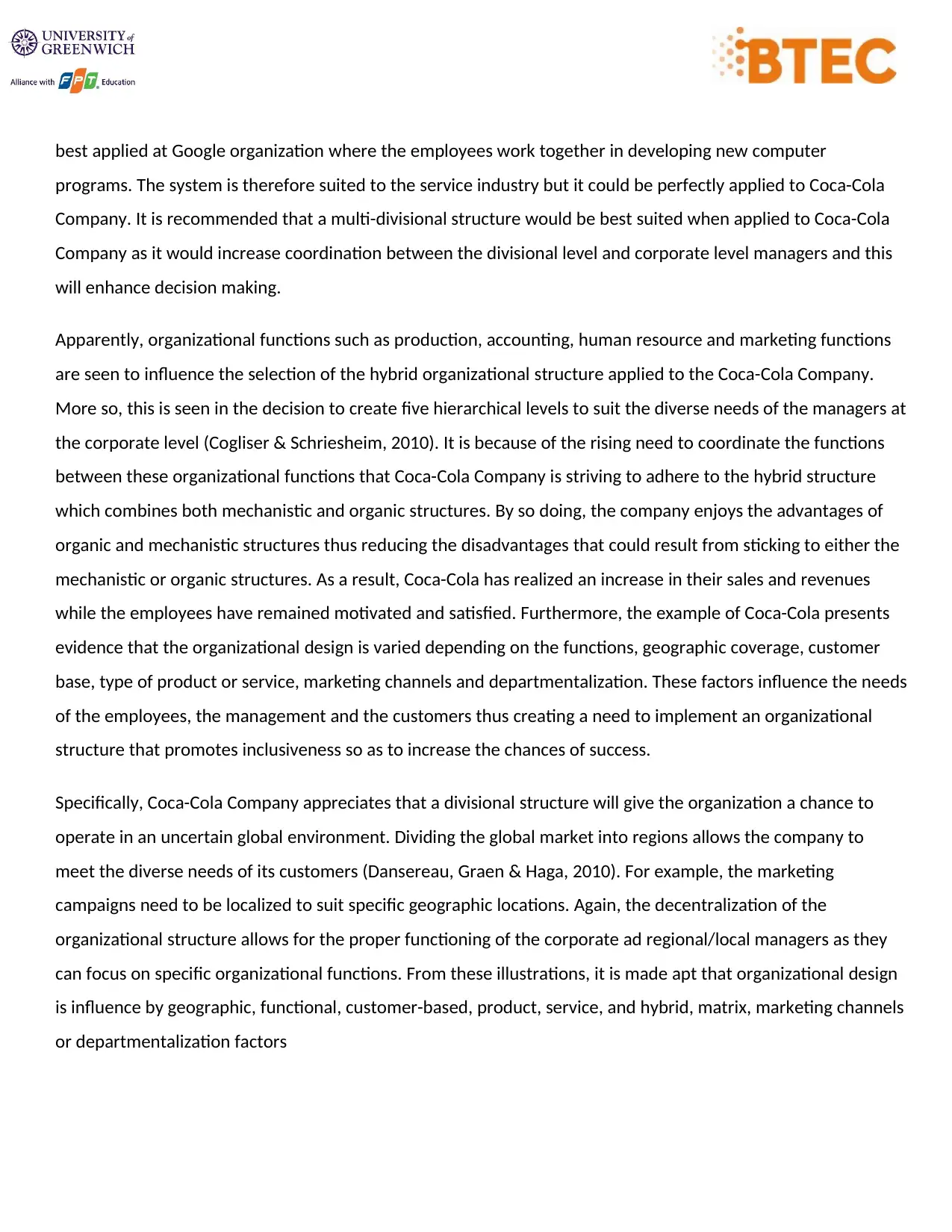
best applied at Google organization where the employees work together in developing new computer
programs. The system is therefore suited to the service industry but it could be perfectly applied to Coca-Cola
Company. It is recommended that a multi-divisional structure would be best suited when applied to Coca-Cola
Company as it would increase coordination between the divisional level and corporate level managers and this
will enhance decision making.
Apparently, organizational functions such as production, accounting, human resource and marketing functions
are seen to influence the selection of the hybrid organizational structure applied to the Coca-Cola Company.
More so, this is seen in the decision to create five hierarchical levels to suit the diverse needs of the managers at
the corporate level (Cogliser & Schriesheim, 2010). It is because of the rising need to coordinate the functions
between these organizational functions that Coca-Cola Company is striving to adhere to the hybrid structure
which combines both mechanistic and organic structures. By so doing, the company enjoys the advantages of
organic and mechanistic structures thus reducing the disadvantages that could result from sticking to either the
mechanistic or organic structures. As a result, Coca-Cola has realized an increase in their sales and revenues
while the employees have remained motivated and satisfied. Furthermore, the example of Coca-Cola presents
evidence that the organizational design is varied depending on the functions, geographic coverage, customer
base, type of product or service, marketing channels and departmentalization. These factors influence the needs
of the employees, the management and the customers thus creating a need to implement an organizational
structure that promotes inclusiveness so as to increase the chances of success.
Specifically, Coca-Cola Company appreciates that a divisional structure will give the organization a chance to
operate in an uncertain global environment. Dividing the global market into regions allows the company to
meet the diverse needs of its customers (Dansereau, Graen & Haga, 2010). For example, the marketing
campaigns need to be localized to suit specific geographic locations. Again, the decentralization of the
organizational structure allows for the proper functioning of the corporate ad regional/local managers as they
can focus on specific organizational functions. From these illustrations, it is made apt that organizational design
is influence by geographic, functional, customer-based, product, service, and hybrid, matrix, marketing channels
or departmentalization factors
programs. The system is therefore suited to the service industry but it could be perfectly applied to Coca-Cola
Company. It is recommended that a multi-divisional structure would be best suited when applied to Coca-Cola
Company as it would increase coordination between the divisional level and corporate level managers and this
will enhance decision making.
Apparently, organizational functions such as production, accounting, human resource and marketing functions
are seen to influence the selection of the hybrid organizational structure applied to the Coca-Cola Company.
More so, this is seen in the decision to create five hierarchical levels to suit the diverse needs of the managers at
the corporate level (Cogliser & Schriesheim, 2010). It is because of the rising need to coordinate the functions
between these organizational functions that Coca-Cola Company is striving to adhere to the hybrid structure
which combines both mechanistic and organic structures. By so doing, the company enjoys the advantages of
organic and mechanistic structures thus reducing the disadvantages that could result from sticking to either the
mechanistic or organic structures. As a result, Coca-Cola has realized an increase in their sales and revenues
while the employees have remained motivated and satisfied. Furthermore, the example of Coca-Cola presents
evidence that the organizational design is varied depending on the functions, geographic coverage, customer
base, type of product or service, marketing channels and departmentalization. These factors influence the needs
of the employees, the management and the customers thus creating a need to implement an organizational
structure that promotes inclusiveness so as to increase the chances of success.
Specifically, Coca-Cola Company appreciates that a divisional structure will give the organization a chance to
operate in an uncertain global environment. Dividing the global market into regions allows the company to
meet the diverse needs of its customers (Dansereau, Graen & Haga, 2010). For example, the marketing
campaigns need to be localized to suit specific geographic locations. Again, the decentralization of the
organizational structure allows for the proper functioning of the corporate ad regional/local managers as they
can focus on specific organizational functions. From these illustrations, it is made apt that organizational design
is influence by geographic, functional, customer-based, product, service, and hybrid, matrix, marketing channels
or departmentalization factors
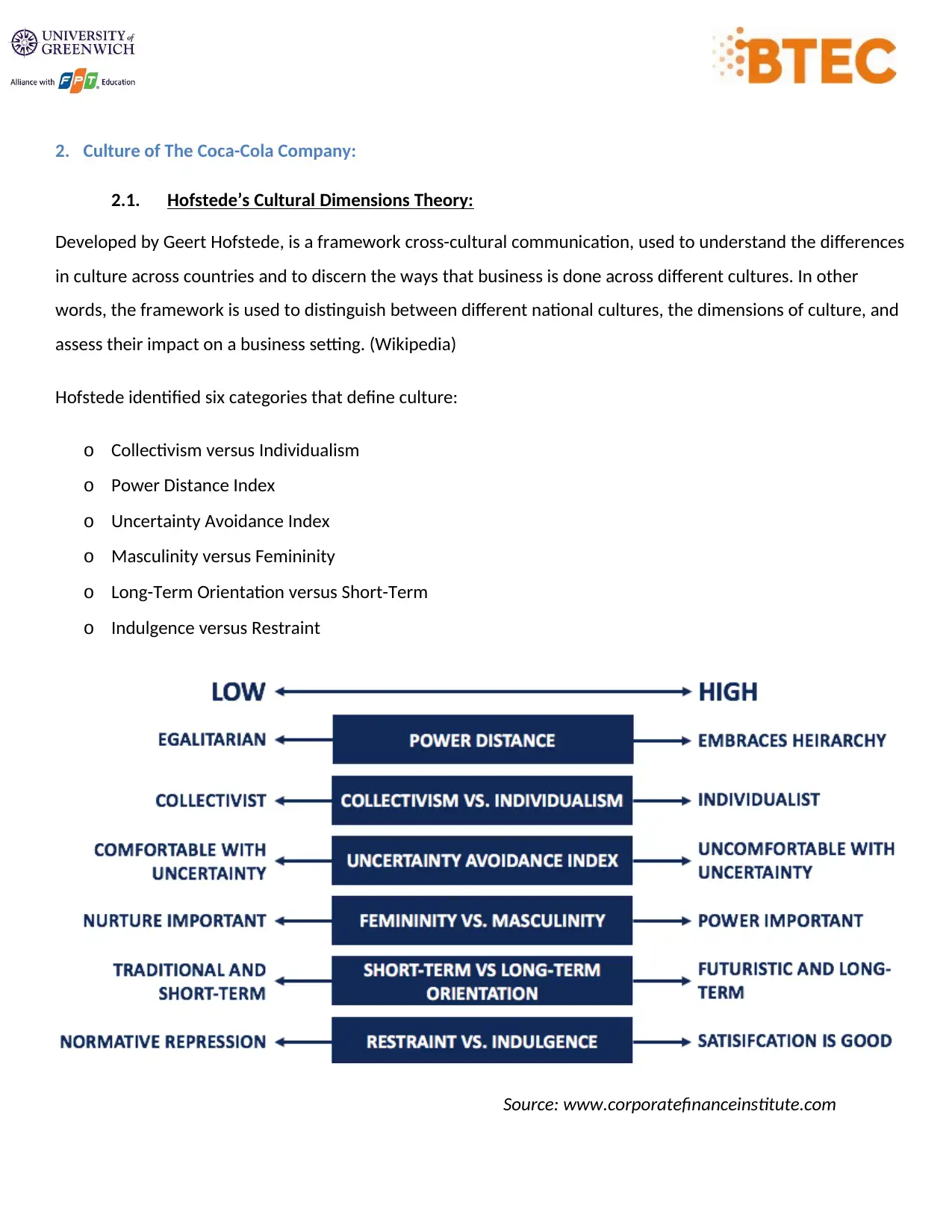
2. Culture of The Coca-Cola Company:
2.1. Hofstede’s Cultural Dimensions Theory:
Developed by Geert Hofstede, is a framework cross-cultural communication, used to understand the differences
in culture across countries and to discern the ways that business is done across different cultures. In other
words, the framework is used to distinguish between different national cultures, the dimensions of culture, and
assess their impact on a business setting. (Wikipedia)
Hofstede identified six categories that define culture:
o Collectivism versus Individualism
o Power Distance Index
o Uncertainty Avoidance Index
o Masculinity versus Femininity
o Long-Term Orientation versus Short-Term
o Indulgence versus Restraint
Source: www.corporatefinanceinstitute.com
2.1. Hofstede’s Cultural Dimensions Theory:
Developed by Geert Hofstede, is a framework cross-cultural communication, used to understand the differences
in culture across countries and to discern the ways that business is done across different cultures. In other
words, the framework is used to distinguish between different national cultures, the dimensions of culture, and
assess their impact on a business setting. (Wikipedia)
Hofstede identified six categories that define culture:
o Collectivism versus Individualism
o Power Distance Index
o Uncertainty Avoidance Index
o Masculinity versus Femininity
o Long-Term Orientation versus Short-Term
o Indulgence versus Restraint
Source: www.corporatefinanceinstitute.com
Secure Best Marks with AI Grader
Need help grading? Try our AI Grader for instant feedback on your assignments.
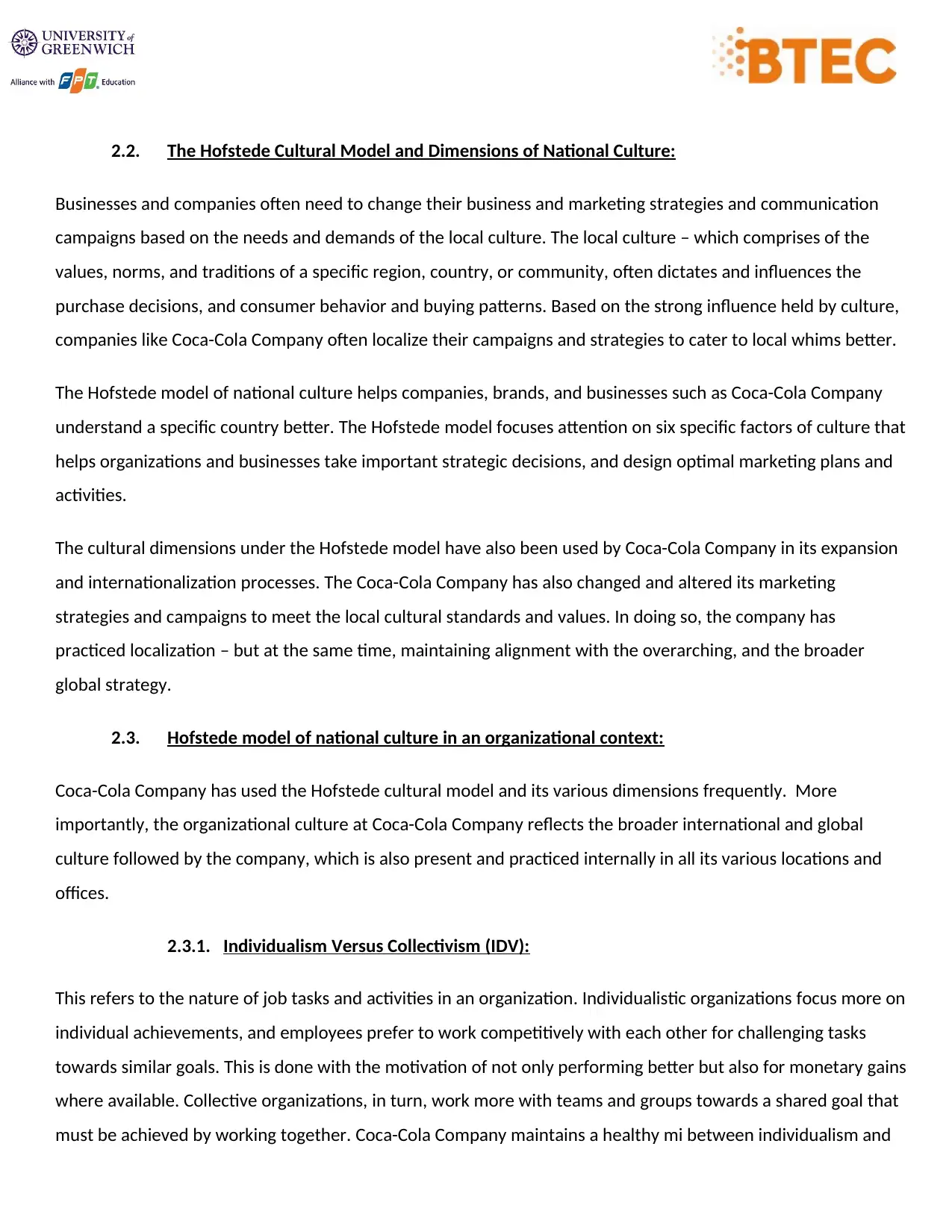
2.2. The Hofstede Cultural Model and Dimensions of National Culture:
Businesses and companies often need to change their business and marketing strategies and communication
campaigns based on the needs and demands of the local culture. The local culture – which comprises of the
values, norms, and traditions of a specific region, country, or community, often dictates and influences the
purchase decisions, and consumer behavior and buying patterns. Based on the strong influence held by culture,
companies like Coca-Cola Company often localize their campaigns and strategies to cater to local whims better.
The Hofstede model of national culture helps companies, brands, and businesses such as Coca-Cola Company
understand a specific country better. The Hofstede model focuses attention on six specific factors of culture that
helps organizations and businesses take important strategic decisions, and design optimal marketing plans and
activities.
The cultural dimensions under the Hofstede model have also been used by Coca-Cola Company in its expansion
and internationalization processes. The Coca-Cola Company has also changed and altered its marketing
strategies and campaigns to meet the local cultural standards and values. In doing so, the company has
practiced localization – but at the same time, maintaining alignment with the overarching, and the broader
global strategy.
2.3. Hofstede model of national culture in an organizational context:
Coca-Cola Company has used the Hofstede cultural model and its various dimensions frequently. More
importantly, the organizational culture at Coca-Cola Company reflects the broader international and global
culture followed by the company, which is also present and practiced internally in all its various locations and
offices.
2.3.1. Individualism Versus Collectivism (IDV):
This refers to the nature of job tasks and activities in an organization. Individualistic organizations focus more on
individual achievements, and employees prefer to work competitively with each other for challenging tasks
towards similar goals. This is done with the motivation of not only performing better but also for monetary gains
where available. Collective organizations, in turn, work more with teams and groups towards a shared goal that
must be achieved by working together. Coca-Cola Company maintains a healthy mi between individualism and
Businesses and companies often need to change their business and marketing strategies and communication
campaigns based on the needs and demands of the local culture. The local culture – which comprises of the
values, norms, and traditions of a specific region, country, or community, often dictates and influences the
purchase decisions, and consumer behavior and buying patterns. Based on the strong influence held by culture,
companies like Coca-Cola Company often localize their campaigns and strategies to cater to local whims better.
The Hofstede model of national culture helps companies, brands, and businesses such as Coca-Cola Company
understand a specific country better. The Hofstede model focuses attention on six specific factors of culture that
helps organizations and businesses take important strategic decisions, and design optimal marketing plans and
activities.
The cultural dimensions under the Hofstede model have also been used by Coca-Cola Company in its expansion
and internationalization processes. The Coca-Cola Company has also changed and altered its marketing
strategies and campaigns to meet the local cultural standards and values. In doing so, the company has
practiced localization – but at the same time, maintaining alignment with the overarching, and the broader
global strategy.
2.3. Hofstede model of national culture in an organizational context:
Coca-Cola Company has used the Hofstede cultural model and its various dimensions frequently. More
importantly, the organizational culture at Coca-Cola Company reflects the broader international and global
culture followed by the company, which is also present and practiced internally in all its various locations and
offices.
2.3.1. Individualism Versus Collectivism (IDV):
This refers to the nature of job tasks and activities in an organization. Individualistic organizations focus more on
individual achievements, and employees prefer to work competitively with each other for challenging tasks
towards similar goals. This is done with the motivation of not only performing better but also for monetary gains
where available. Collective organizations, in turn, work more with teams and groups towards a shared goal that
must be achieved by working together. Coca-Cola Company maintains a healthy mi between individualism and

collectivism in its organizational culture to promote optimal performance in employees and fuel the business
growth appropriately.
2.3.1.1. Privacy:
Coca-Cola Company values the privacy of its employees in their workspace as well as personal life. The
organization does not encroach on an employee’s personal matters, and gives them the needed privacy as and
when required, and also offers assistance where needed.
2.3.1.2. Time:
Coca-Cola Company also values the time of its employees. All tasks and job activities are planned so that an
individual’s social and personal life is not impacted, and a work-life balance is maintained. This work-life balance
is important for the employees' emotional and physical well-being, and Coca-Cola Company ensures that
employees are valued for their time as well.
2.3.1.3. Challenging Tasks:
Coca-Cola Company regularly and frequently engages its employees with challenging tasks and goals. These
tasks and goals aim to engage the employees and keep them motivated to perform optimally. Coca-Cola
Company invests in ensuring that all its employees are challenged to not get bored and dissatisfied with their
job roles.
2.3.1.4. Individual Accomplishments:
Individual accomplishments at Coca-Cola Company are celebrated. Employees are recognized for their
performances and individual accomplishments – professional as well as personal. The appreciation and
celebration are made through intrinsic as well as extrinsic benefits which helps spike the motivation of
employees further toward improvement.
2.3.1.5. Work-life versus Social life:
Coca-Cola Company maintains a clear demarcation between an employee’s personal and social life, and ensure
that the workplace culture is not infiltrated with social relationships and social contracts. While the Coca-Cola
Company values and encourages an employee’s social life and social relationships, it deems it against the
growth appropriately.
2.3.1.1. Privacy:
Coca-Cola Company values the privacy of its employees in their workspace as well as personal life. The
organization does not encroach on an employee’s personal matters, and gives them the needed privacy as and
when required, and also offers assistance where needed.
2.3.1.2. Time:
Coca-Cola Company also values the time of its employees. All tasks and job activities are planned so that an
individual’s social and personal life is not impacted, and a work-life balance is maintained. This work-life balance
is important for the employees' emotional and physical well-being, and Coca-Cola Company ensures that
employees are valued for their time as well.
2.3.1.3. Challenging Tasks:
Coca-Cola Company regularly and frequently engages its employees with challenging tasks and goals. These
tasks and goals aim to engage the employees and keep them motivated to perform optimally. Coca-Cola
Company invests in ensuring that all its employees are challenged to not get bored and dissatisfied with their
job roles.
2.3.1.4. Individual Accomplishments:
Individual accomplishments at Coca-Cola Company are celebrated. Employees are recognized for their
performances and individual accomplishments – professional as well as personal. The appreciation and
celebration are made through intrinsic as well as extrinsic benefits which helps spike the motivation of
employees further toward improvement.
2.3.1.5. Work-life versus Social life:
Coca-Cola Company maintains a clear demarcation between an employee’s personal and social life, and ensure
that the workplace culture is not infiltrated with social relationships and social contracts. While the Coca-Cola
Company values and encourages an employee’s social life and social relationships, it deems it against the
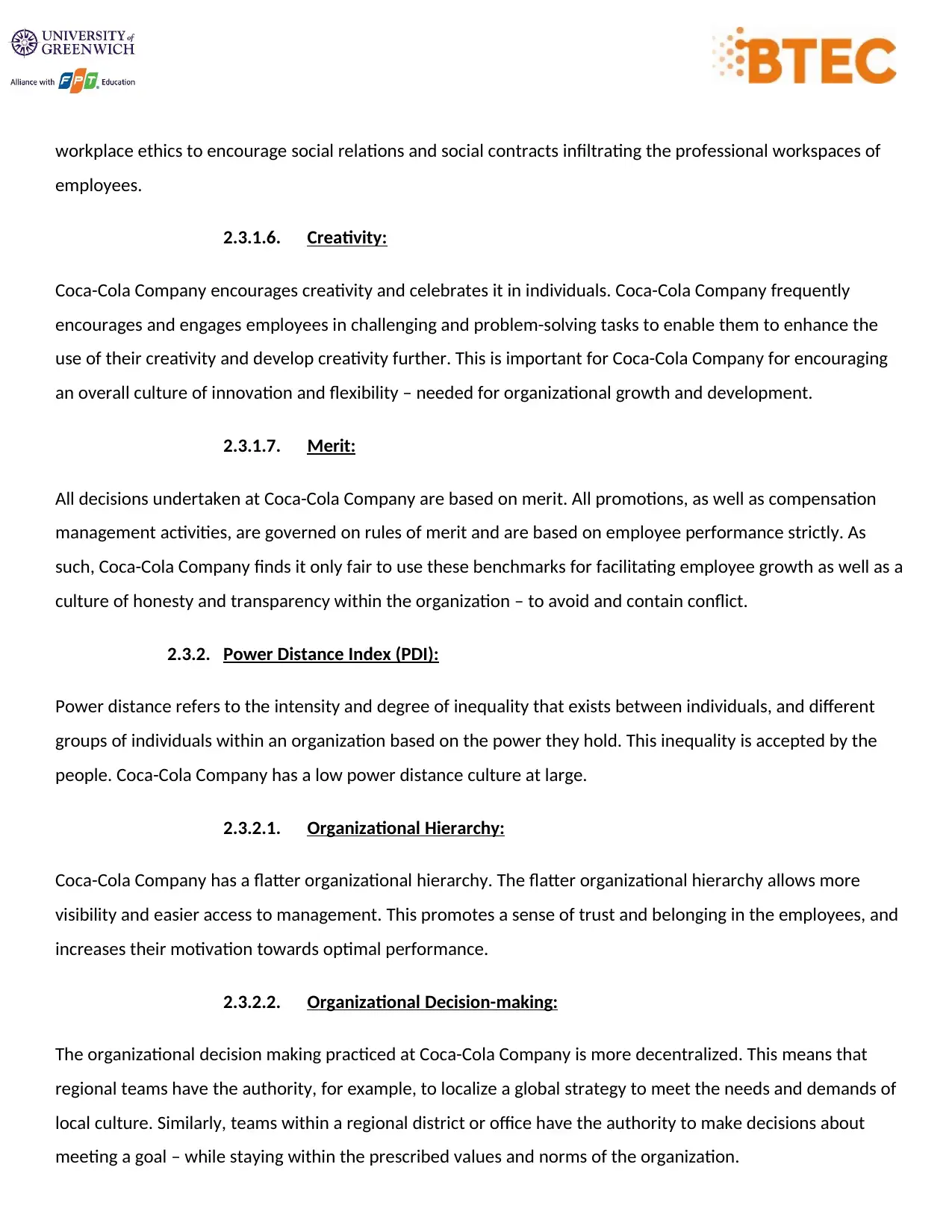
workplace ethics to encourage social relations and social contracts infiltrating the professional workspaces of
employees.
2.3.1.6. Creativity:
Coca-Cola Company encourages creativity and celebrates it in individuals. Coca-Cola Company frequently
encourages and engages employees in challenging and problem-solving tasks to enable them to enhance the
use of their creativity and develop creativity further. This is important for Coca-Cola Company for encouraging
an overall culture of innovation and flexibility – needed for organizational growth and development.
2.3.1.7. Merit:
All decisions undertaken at Coca-Cola Company are based on merit. All promotions, as well as compensation
management activities, are governed on rules of merit and are based on employee performance strictly. As
such, Coca-Cola Company finds it only fair to use these benchmarks for facilitating employee growth as well as a
culture of honesty and transparency within the organization – to avoid and contain conflict.
2.3.2. Power Distance Index (PDI):
Power distance refers to the intensity and degree of inequality that exists between individuals, and different
groups of individuals within an organization based on the power they hold. This inequality is accepted by the
people. Coca-Cola Company has a low power distance culture at large.
2.3.2.1. Organizational Hierarchy:
Coca-Cola Company has a flatter organizational hierarchy. The flatter organizational hierarchy allows more
visibility and easier access to management. This promotes a sense of trust and belonging in the employees, and
increases their motivation towards optimal performance.
2.3.2.2. Organizational Decision-making:
The organizational decision making practiced at Coca-Cola Company is more decentralized. This means that
regional teams have the authority, for example, to localize a global strategy to meet the needs and demands of
local culture. Similarly, teams within a regional district or office have the authority to make decisions about
meeting a goal – while staying within the prescribed values and norms of the organization.
employees.
2.3.1.6. Creativity:
Coca-Cola Company encourages creativity and celebrates it in individuals. Coca-Cola Company frequently
encourages and engages employees in challenging and problem-solving tasks to enable them to enhance the
use of their creativity and develop creativity further. This is important for Coca-Cola Company for encouraging
an overall culture of innovation and flexibility – needed for organizational growth and development.
2.3.1.7. Merit:
All decisions undertaken at Coca-Cola Company are based on merit. All promotions, as well as compensation
management activities, are governed on rules of merit and are based on employee performance strictly. As
such, Coca-Cola Company finds it only fair to use these benchmarks for facilitating employee growth as well as a
culture of honesty and transparency within the organization – to avoid and contain conflict.
2.3.2. Power Distance Index (PDI):
Power distance refers to the intensity and degree of inequality that exists between individuals, and different
groups of individuals within an organization based on the power they hold. This inequality is accepted by the
people. Coca-Cola Company has a low power distance culture at large.
2.3.2.1. Organizational Hierarchy:
Coca-Cola Company has a flatter organizational hierarchy. The flatter organizational hierarchy allows more
visibility and easier access to management. This promotes a sense of trust and belonging in the employees, and
increases their motivation towards optimal performance.
2.3.2.2. Organizational Decision-making:
The organizational decision making practiced at Coca-Cola Company is more decentralized. This means that
regional teams have the authority, for example, to localize a global strategy to meet the needs and demands of
local culture. Similarly, teams within a regional district or office have the authority to make decisions about
meeting a goal – while staying within the prescribed values and norms of the organization.
Paraphrase This Document
Need a fresh take? Get an instant paraphrase of this document with our AI Paraphraser
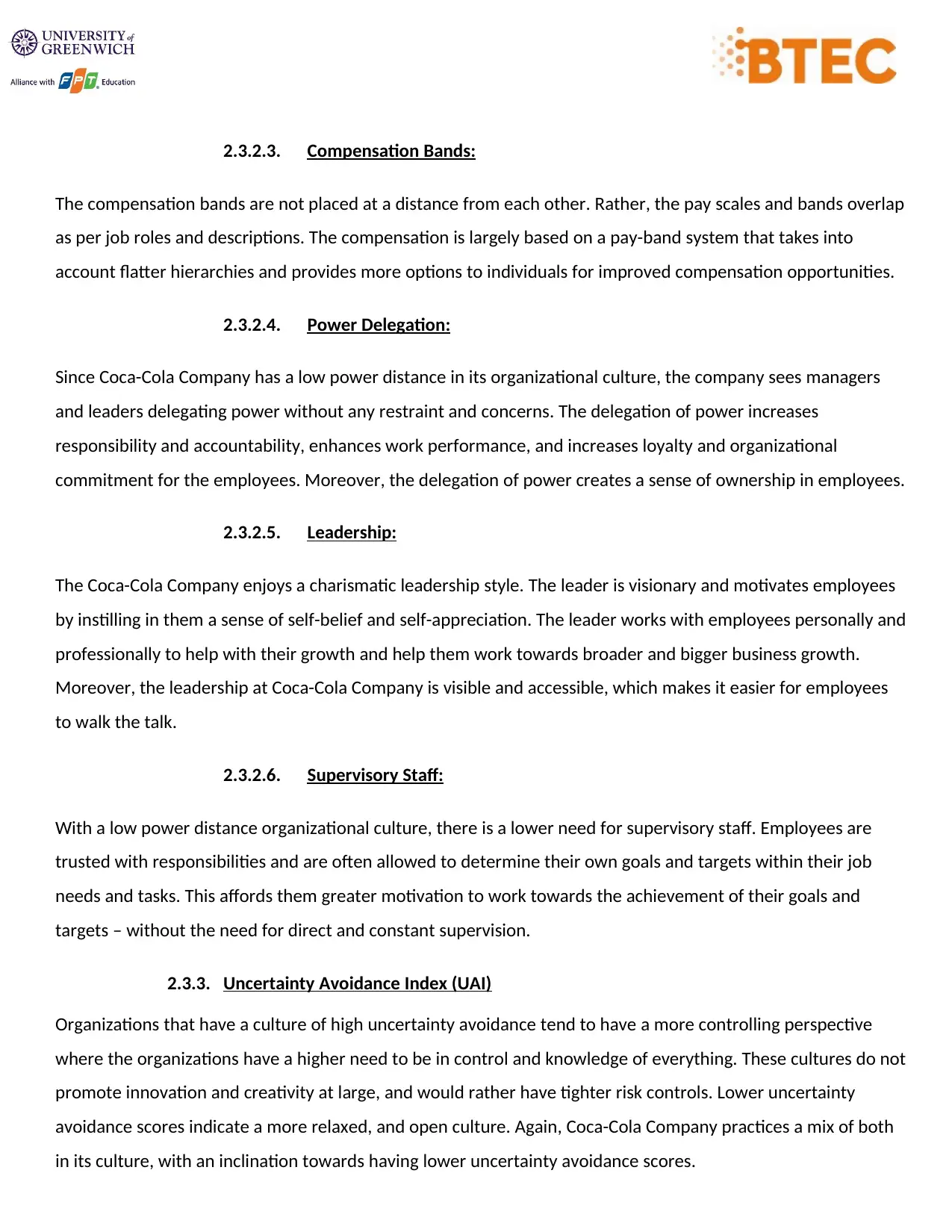
2.3.2.3. Compensation Bands:
The compensation bands are not placed at a distance from each other. Rather, the pay scales and bands overlap
as per job roles and descriptions. The compensation is largely based on a pay-band system that takes into
account flatter hierarchies and provides more options to individuals for improved compensation opportunities.
2.3.2.4. Power Delegation:
Since Coca-Cola Company has a low power distance in its organizational culture, the company sees managers
and leaders delegating power without any restraint and concerns. The delegation of power increases
responsibility and accountability, enhances work performance, and increases loyalty and organizational
commitment for the employees. Moreover, the delegation of power creates a sense of ownership in employees.
2.3.2.5. Leadership:
The Coca-Cola Company enjoys a charismatic leadership style. The leader is visionary and motivates employees
by instilling in them a sense of self-belief and self-appreciation. The leader works with employees personally and
professionally to help with their growth and help them work towards broader and bigger business growth.
Moreover, the leadership at Coca-Cola Company is visible and accessible, which makes it easier for employees
to walk the talk.
2.3.2.6. Supervisory Staff:
With a low power distance organizational culture, there is a lower need for supervisory staff. Employees are
trusted with responsibilities and are often allowed to determine their own goals and targets within their job
needs and tasks. This affords them greater motivation to work towards the achievement of their goals and
targets – without the need for direct and constant supervision.
2.3.3. Uncertainty Avoidance Index (UAI)
Organizations that have a culture of high uncertainty avoidance tend to have a more controlling perspective
where the organizations have a higher need to be in control and knowledge of everything. These cultures do not
promote innovation and creativity at large, and would rather have tighter risk controls. Lower uncertainty
avoidance scores indicate a more relaxed, and open culture. Again, Coca-Cola Company practices a mix of both
in its culture, with an inclination towards having lower uncertainty avoidance scores.
The compensation bands are not placed at a distance from each other. Rather, the pay scales and bands overlap
as per job roles and descriptions. The compensation is largely based on a pay-band system that takes into
account flatter hierarchies and provides more options to individuals for improved compensation opportunities.
2.3.2.4. Power Delegation:
Since Coca-Cola Company has a low power distance in its organizational culture, the company sees managers
and leaders delegating power without any restraint and concerns. The delegation of power increases
responsibility and accountability, enhances work performance, and increases loyalty and organizational
commitment for the employees. Moreover, the delegation of power creates a sense of ownership in employees.
2.3.2.5. Leadership:
The Coca-Cola Company enjoys a charismatic leadership style. The leader is visionary and motivates employees
by instilling in them a sense of self-belief and self-appreciation. The leader works with employees personally and
professionally to help with their growth and help them work towards broader and bigger business growth.
Moreover, the leadership at Coca-Cola Company is visible and accessible, which makes it easier for employees
to walk the talk.
2.3.2.6. Supervisory Staff:
With a low power distance organizational culture, there is a lower need for supervisory staff. Employees are
trusted with responsibilities and are often allowed to determine their own goals and targets within their job
needs and tasks. This affords them greater motivation to work towards the achievement of their goals and
targets – without the need for direct and constant supervision.
2.3.3. Uncertainty Avoidance Index (UAI)
Organizations that have a culture of high uncertainty avoidance tend to have a more controlling perspective
where the organizations have a higher need to be in control and knowledge of everything. These cultures do not
promote innovation and creativity at large, and would rather have tighter risk controls. Lower uncertainty
avoidance scores indicate a more relaxed, and open culture. Again, Coca-Cola Company practices a mix of both
in its culture, with an inclination towards having lower uncertainty avoidance scores.

2.3.3.1. Opened to Change:
Coca-Cola Company encourages a culture internal to the organization that is open to change. The company
frequently engages in change management programs to improve its processes, cultures, as well as work
activities through team building activities. The frequent changes have allowed the organization to become more
adaptable to changes in the internal and external environments without affecting the performance of
employees. Moreover, this has encouraged innovation in the organization as well.
2.3.3.2. Learning and Decision-making Processes:
The learning and decision-making processes are more open-ended in nature. There is less rigidity, and
employees are encouraged to engage in fruitful debates and discussions to weigh the pros and cons of various
decisions before reaching a unanimous decision that is agreeable by all groups present and needed in point.
2.3.3.3. Sense of Urgency:
Coca-Cola Company encourages a flatter hierarchy within the organization, and as such, does not place much
importance on tiles. Instead, the company focuses more on merit-based behavior and celebrates employees
who do not break under pressure. Moreover, there is a lower sense of urgency in the organization, and
employees enjoy a more relaxed internal culture.
2.3.3.4. Risk-taking:
Coca-Cola Company can fairly be seen as a risk-taking organization. The company’s ability to take risks highlights
its need to explore, and benefit from opportunities – as well as avoid failure. The company’s readiness and
motivation to take needs also highlight it to be more inclined towards lower uncertainty avoidance.
2.3.3.5. Flexibilities:
Coca-Cola Company is flexible in its strategies as well as various departmental activities – to meet the needs and
demands of the organizational goals as well as country-specific needs. In doing so, Coca-Cola Company has
become an avid practitioner of localization – which is based on principles of flexibility and adaptability.
Coca-Cola Company encourages a culture internal to the organization that is open to change. The company
frequently engages in change management programs to improve its processes, cultures, as well as work
activities through team building activities. The frequent changes have allowed the organization to become more
adaptable to changes in the internal and external environments without affecting the performance of
employees. Moreover, this has encouraged innovation in the organization as well.
2.3.3.2. Learning and Decision-making Processes:
The learning and decision-making processes are more open-ended in nature. There is less rigidity, and
employees are encouraged to engage in fruitful debates and discussions to weigh the pros and cons of various
decisions before reaching a unanimous decision that is agreeable by all groups present and needed in point.
2.3.3.3. Sense of Urgency:
Coca-Cola Company encourages a flatter hierarchy within the organization, and as such, does not place much
importance on tiles. Instead, the company focuses more on merit-based behavior and celebrates employees
who do not break under pressure. Moreover, there is a lower sense of urgency in the organization, and
employees enjoy a more relaxed internal culture.
2.3.3.4. Risk-taking:
Coca-Cola Company can fairly be seen as a risk-taking organization. The company’s ability to take risks highlights
its need to explore, and benefit from opportunities – as well as avoid failure. The company’s readiness and
motivation to take needs also highlight it to be more inclined towards lower uncertainty avoidance.
2.3.3.5. Flexibilities:
Coca-Cola Company is flexible in its strategies as well as various departmental activities – to meet the needs and
demands of the organizational goals as well as country-specific needs. In doing so, Coca-Cola Company has
become an avid practitioner of localization – which is based on principles of flexibility and adaptability.
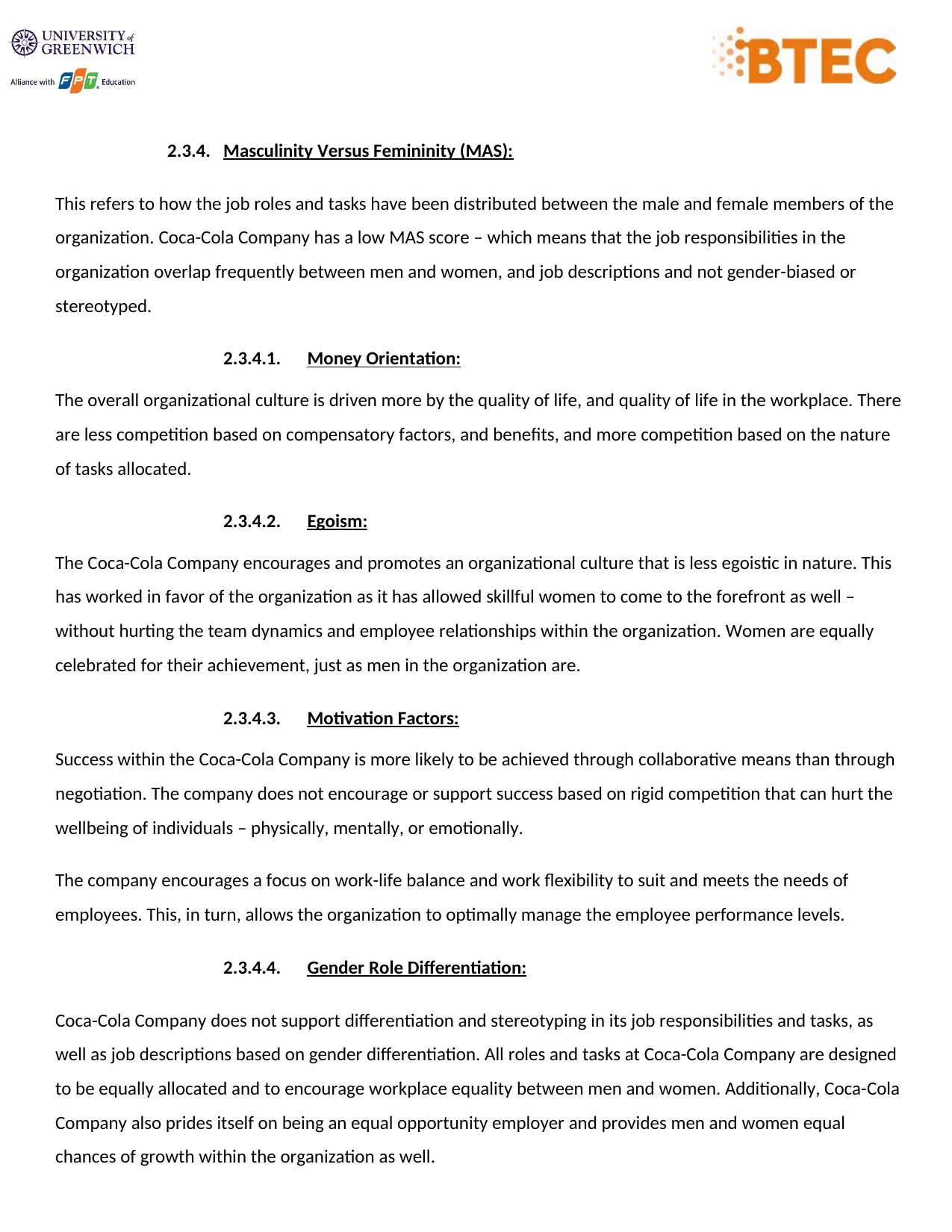
2.3.4. Masculinity Versus Femininity (MAS):
This refers to how the job roles and tasks have been distributed between the male and female members of the
organization. Coca-Cola Company has a low MAS score – which means that the job responsibilities in the
organization overlap frequently between men and women, and job descriptions and not gender-biased or
stereotyped.
2.3.4.1. Money Orientation:
The overall organizational culture is driven more by the quality of life, and quality of life in the workplace. There
are less competition based on compensatory factors, and benefits, and more competition based on the nature
of tasks allocated.
2.3.4.2. Egoism:
The Coca-Cola Company encourages and promotes an organizational culture that is less egoistic in nature. This
has worked in favor of the organization as it has allowed skillful women to come to the forefront as well –
without hurting the team dynamics and employee relationships within the organization. Women are equally
celebrated for their achievement, just as men in the organization are.
2.3.4.3. Motivation Factors:
Success within the Coca-Cola Company is more likely to be achieved through collaborative means than through
negotiation. The company does not encourage or support success based on rigid competition that can hurt the
wellbeing of individuals – physically, mentally, or emotionally.
The company encourages a focus on work-life balance and work flexibility to suit and meets the needs of
employees. This, in turn, allows the organization to optimally manage the employee performance levels.
2.3.4.4. Gender Role Differentiation:
Coca-Cola Company does not support differentiation and stereotyping in its job responsibilities and tasks, as
well as job descriptions based on gender differentiation. All roles and tasks at Coca-Cola Company are designed
to be equally allocated and to encourage workplace equality between men and women. Additionally, Coca-Cola
Company also prides itself on being an equal opportunity employer and provides men and women equal
chances of growth within the organization as well.
This refers to how the job roles and tasks have been distributed between the male and female members of the
organization. Coca-Cola Company has a low MAS score – which means that the job responsibilities in the
organization overlap frequently between men and women, and job descriptions and not gender-biased or
stereotyped.
2.3.4.1. Money Orientation:
The overall organizational culture is driven more by the quality of life, and quality of life in the workplace. There
are less competition based on compensatory factors, and benefits, and more competition based on the nature
of tasks allocated.
2.3.4.2. Egoism:
The Coca-Cola Company encourages and promotes an organizational culture that is less egoistic in nature. This
has worked in favor of the organization as it has allowed skillful women to come to the forefront as well –
without hurting the team dynamics and employee relationships within the organization. Women are equally
celebrated for their achievement, just as men in the organization are.
2.3.4.3. Motivation Factors:
Success within the Coca-Cola Company is more likely to be achieved through collaborative means than through
negotiation. The company does not encourage or support success based on rigid competition that can hurt the
wellbeing of individuals – physically, mentally, or emotionally.
The company encourages a focus on work-life balance and work flexibility to suit and meets the needs of
employees. This, in turn, allows the organization to optimally manage the employee performance levels.
2.3.4.4. Gender Role Differentiation:
Coca-Cola Company does not support differentiation and stereotyping in its job responsibilities and tasks, as
well as job descriptions based on gender differentiation. All roles and tasks at Coca-Cola Company are designed
to be equally allocated and to encourage workplace equality between men and women. Additionally, Coca-Cola
Company also prides itself on being an equal opportunity employer and provides men and women equal
chances of growth within the organization as well.
Secure Best Marks with AI Grader
Need help grading? Try our AI Grader for instant feedback on your assignments.

2.3.5. Long-Term Orientation versus Short-Term (LTO):
Cultures displaying higher long term orientation are more thrifty and pragmatic in nature. They display their
understanding of time as having long term implications – well spread out over the future. In contrast, cultures
displaying short orientation are more nationalistic and values-driven. Coca-Cola Company operates with a long
term orientation in this strategic focus and development, while execution and related activities of the same are
driven more by short term orientation.
2.3.5.1. Focus on Thrift and Education:
Coca-Cola Company The place sigh importance on education and merit of its employees. Not only does the
company hire the best and the most educated class for its various positions and jobs, but the company also
ensures that employees are continually in the learning cycle through job tasks, engagement, and training.
2.3.5.2. Values and Rights:
Coca-Cola Company places high importance on the values and rights of the people and various groups in
societies and communities – including minority groups. The company is an equal opportunity employer, and as
such, provides equal opportunities to all groups in all processes related to the firm and its staffing polis.
2.3.5.3. Obligations and Virtues:
The Coca-Cola Company is equally careful, and mindful about its obligations and cities. The company engages in
CSR cities regularly for example, as an obligation it holds towards the broader society in which it operates. The
CSR activities of the company are ongoing, and carefully planned and executed to represent the aim and
philosophy of the company.
2.3.5.4. How versus Why:
The Coca-Cola Company and its employees are generally more interested in the how and what, rather than the
why of the problem. This indicates a more problem-solving attitude and an inclination towards long term
orientation. This allows the people to be able to understand the cause, rather than symptoms to be able to
completely solve problems, and improve personal and organizational performance.
Cultures displaying higher long term orientation are more thrifty and pragmatic in nature. They display their
understanding of time as having long term implications – well spread out over the future. In contrast, cultures
displaying short orientation are more nationalistic and values-driven. Coca-Cola Company operates with a long
term orientation in this strategic focus and development, while execution and related activities of the same are
driven more by short term orientation.
2.3.5.1. Focus on Thrift and Education:
Coca-Cola Company The place sigh importance on education and merit of its employees. Not only does the
company hire the best and the most educated class for its various positions and jobs, but the company also
ensures that employees are continually in the learning cycle through job tasks, engagement, and training.
2.3.5.2. Values and Rights:
Coca-Cola Company places high importance on the values and rights of the people and various groups in
societies and communities – including minority groups. The company is an equal opportunity employer, and as
such, provides equal opportunities to all groups in all processes related to the firm and its staffing polis.
2.3.5.3. Obligations and Virtues:
The Coca-Cola Company is equally careful, and mindful about its obligations and cities. The company engages in
CSR cities regularly for example, as an obligation it holds towards the broader society in which it operates. The
CSR activities of the company are ongoing, and carefully planned and executed to represent the aim and
philosophy of the company.
2.3.5.4. How versus Why:
The Coca-Cola Company and its employees are generally more interested in the how and what, rather than the
why of the problem. This indicates a more problem-solving attitude and an inclination towards long term
orientation. This allows the people to be able to understand the cause, rather than symptoms to be able to
completely solve problems, and improve personal and organizational performance.

2.3.6. Indulgence versus Restraint (IVR):
A higher indulgence score indicates a culture to be more affording towards people’s personal gratification as
well as their happiness and needs. A more restraining culture, on the other hand, indicates a culture governed
by social norms and rules. For Coca-Cola Company, the organizational culture is a healthy mix between the two,
with an inclination toward indulgence.
2.3.6.1. Optimism:
The overall culture at Coca-Cola Company is optimistic, where employees are treated with respect. All
employees are also trained frequently to remain calm and work with a focus – even in situations of worry.
Moreover, employees are also trained towards personal emotional wellbeing and offered counselling in dealing
with personal troubles if needed. These indicate that while the organization works in the best interest of its
employees, it also projects a fairly optimistic image.
2.3.6.2. Personal Happiness:
Coca-Cola Company values the happiness of its individuals. The culture and internal organizational environment
are relaxed and vibrant. Employees feel at ease with each other and are comfortable in the presence of their
colleagues. As such, the organization enjoys happiness and values the happiness of employees over everything
else. For the same reason, the organization also offers training and opportunities for cultivating personal goals
and targets that are not professionally measured.
2.3.6.3. Freedom of Speech:
Coca-Cola Company offers freedom of speech to its employees. The organization allows employees to speak
what is on their minds in a reasoned and well-behaved manner. Moreover, the organization also encourages
debate, and regular feedback from employees to continually enhance and improve the organizational products
as well as the internal culture and environment.
2.4. The culture impacts on behaviors and performance of teams and individuals within workplace:
(Coca-Cola Amatil Websit.2020)
Respect for human rights is fundamental to the sustainability of Amatil and the communities in which we
operate.
A higher indulgence score indicates a culture to be more affording towards people’s personal gratification as
well as their happiness and needs. A more restraining culture, on the other hand, indicates a culture governed
by social norms and rules. For Coca-Cola Company, the organizational culture is a healthy mix between the two,
with an inclination toward indulgence.
2.3.6.1. Optimism:
The overall culture at Coca-Cola Company is optimistic, where employees are treated with respect. All
employees are also trained frequently to remain calm and work with a focus – even in situations of worry.
Moreover, employees are also trained towards personal emotional wellbeing and offered counselling in dealing
with personal troubles if needed. These indicate that while the organization works in the best interest of its
employees, it also projects a fairly optimistic image.
2.3.6.2. Personal Happiness:
Coca-Cola Company values the happiness of its individuals. The culture and internal organizational environment
are relaxed and vibrant. Employees feel at ease with each other and are comfortable in the presence of their
colleagues. As such, the organization enjoys happiness and values the happiness of employees over everything
else. For the same reason, the organization also offers training and opportunities for cultivating personal goals
and targets that are not professionally measured.
2.3.6.3. Freedom of Speech:
Coca-Cola Company offers freedom of speech to its employees. The organization allows employees to speak
what is on their minds in a reasoned and well-behaved manner. Moreover, the organization also encourages
debate, and regular feedback from employees to continually enhance and improve the organizational products
as well as the internal culture and environment.
2.4. The culture impacts on behaviors and performance of teams and individuals within workplace:
(Coca-Cola Amatil Websit.2020)
Respect for human rights is fundamental to the sustainability of Amatil and the communities in which we
operate.
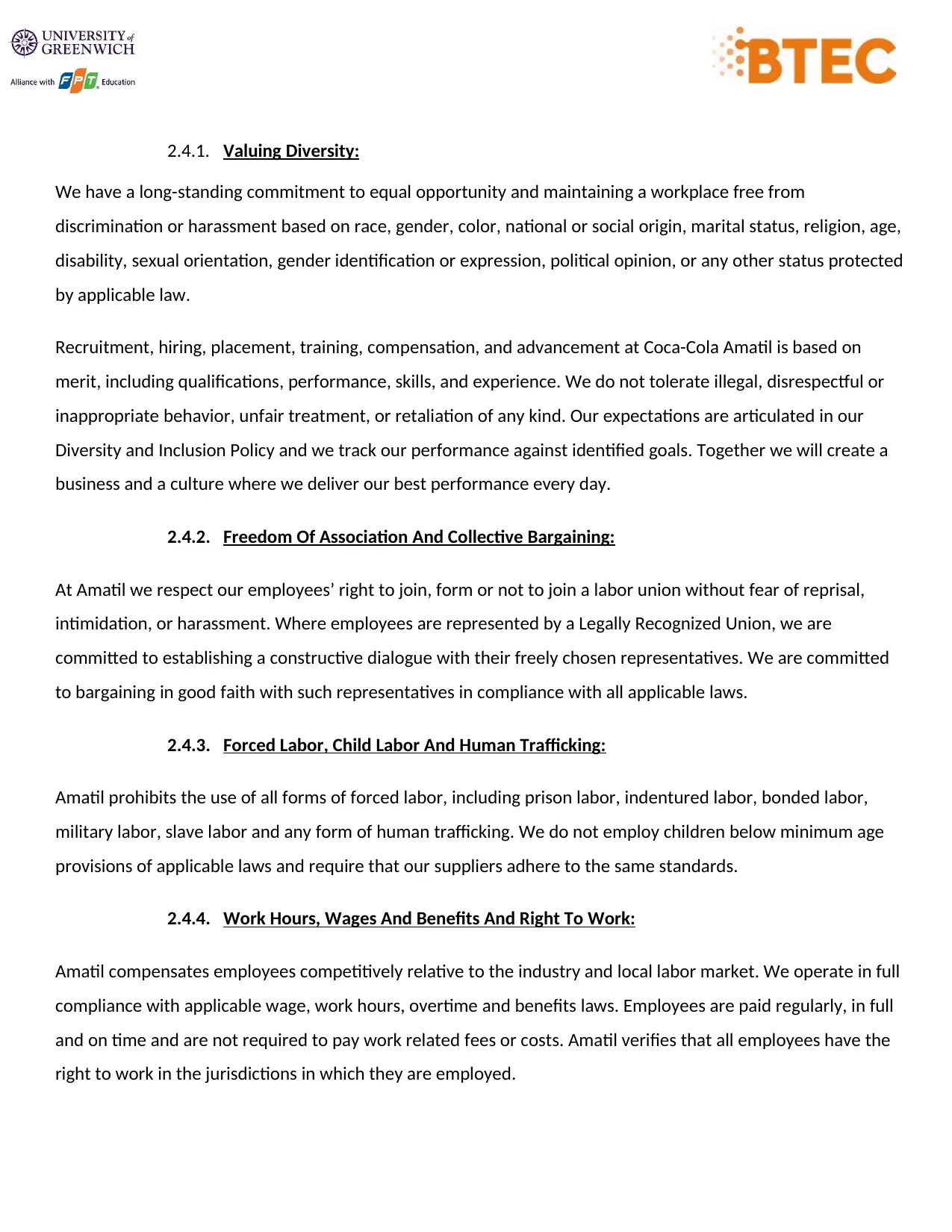
2.4.1. Valuing Diversity:
We have a long-standing commitment to equal opportunity and maintaining a workplace free from
discrimination or harassment based on race, gender, color, national or social origin, marital status, religion, age,
disability, sexual orientation, gender identification or expression, political opinion, or any other status protected
by applicable law.
Recruitment, hiring, placement, training, compensation, and advancement at Coca-Cola Amatil is based on
merit, including qualifications, performance, skills, and experience. We do not tolerate illegal, disrespectful or
inappropriate behavior, unfair treatment, or retaliation of any kind. Our expectations are articulated in our
Diversity and Inclusion Policy and we track our performance against identified goals. Together we will create a
business and a culture where we deliver our best performance every day.
2.4.2. Freedom Of Association And Collective Bargaining:
At Amatil we respect our employees’ right to join, form or not to join a labor union without fear of reprisal,
intimidation, or harassment. Where employees are represented by a Legally Recognized Union, we are
committed to establishing a constructive dialogue with their freely chosen representatives. We are committed
to bargaining in good faith with such representatives in compliance with all applicable laws.
2.4.3. Forced Labor, Child Labor And Human Trafficking:
Amatil prohibits the use of all forms of forced labor, including prison labor, indentured labor, bonded labor,
military labor, slave labor and any form of human trafficking. We do not employ children below minimum age
provisions of applicable laws and require that our suppliers adhere to the same standards.
2.4.4. Work Hours, Wages And Benefits And Right To Work:
Amatil compensates employees competitively relative to the industry and local labor market. We operate in full
compliance with applicable wage, work hours, overtime and benefits laws. Employees are paid regularly, in full
and on time and are not required to pay work related fees or costs. Amatil verifies that all employees have the
right to work in the jurisdictions in which they are employed.
We have a long-standing commitment to equal opportunity and maintaining a workplace free from
discrimination or harassment based on race, gender, color, national or social origin, marital status, religion, age,
disability, sexual orientation, gender identification or expression, political opinion, or any other status protected
by applicable law.
Recruitment, hiring, placement, training, compensation, and advancement at Coca-Cola Amatil is based on
merit, including qualifications, performance, skills, and experience. We do not tolerate illegal, disrespectful or
inappropriate behavior, unfair treatment, or retaliation of any kind. Our expectations are articulated in our
Diversity and Inclusion Policy and we track our performance against identified goals. Together we will create a
business and a culture where we deliver our best performance every day.
2.4.2. Freedom Of Association And Collective Bargaining:
At Amatil we respect our employees’ right to join, form or not to join a labor union without fear of reprisal,
intimidation, or harassment. Where employees are represented by a Legally Recognized Union, we are
committed to establishing a constructive dialogue with their freely chosen representatives. We are committed
to bargaining in good faith with such representatives in compliance with all applicable laws.
2.4.3. Forced Labor, Child Labor And Human Trafficking:
Amatil prohibits the use of all forms of forced labor, including prison labor, indentured labor, bonded labor,
military labor, slave labor and any form of human trafficking. We do not employ children below minimum age
provisions of applicable laws and require that our suppliers adhere to the same standards.
2.4.4. Work Hours, Wages And Benefits And Right To Work:
Amatil compensates employees competitively relative to the industry and local labor market. We operate in full
compliance with applicable wage, work hours, overtime and benefits laws. Employees are paid regularly, in full
and on time and are not required to pay work related fees or costs. Amatil verifies that all employees have the
right to work in the jurisdictions in which they are employed.
Paraphrase This Document
Need a fresh take? Get an instant paraphrase of this document with our AI Paraphraser
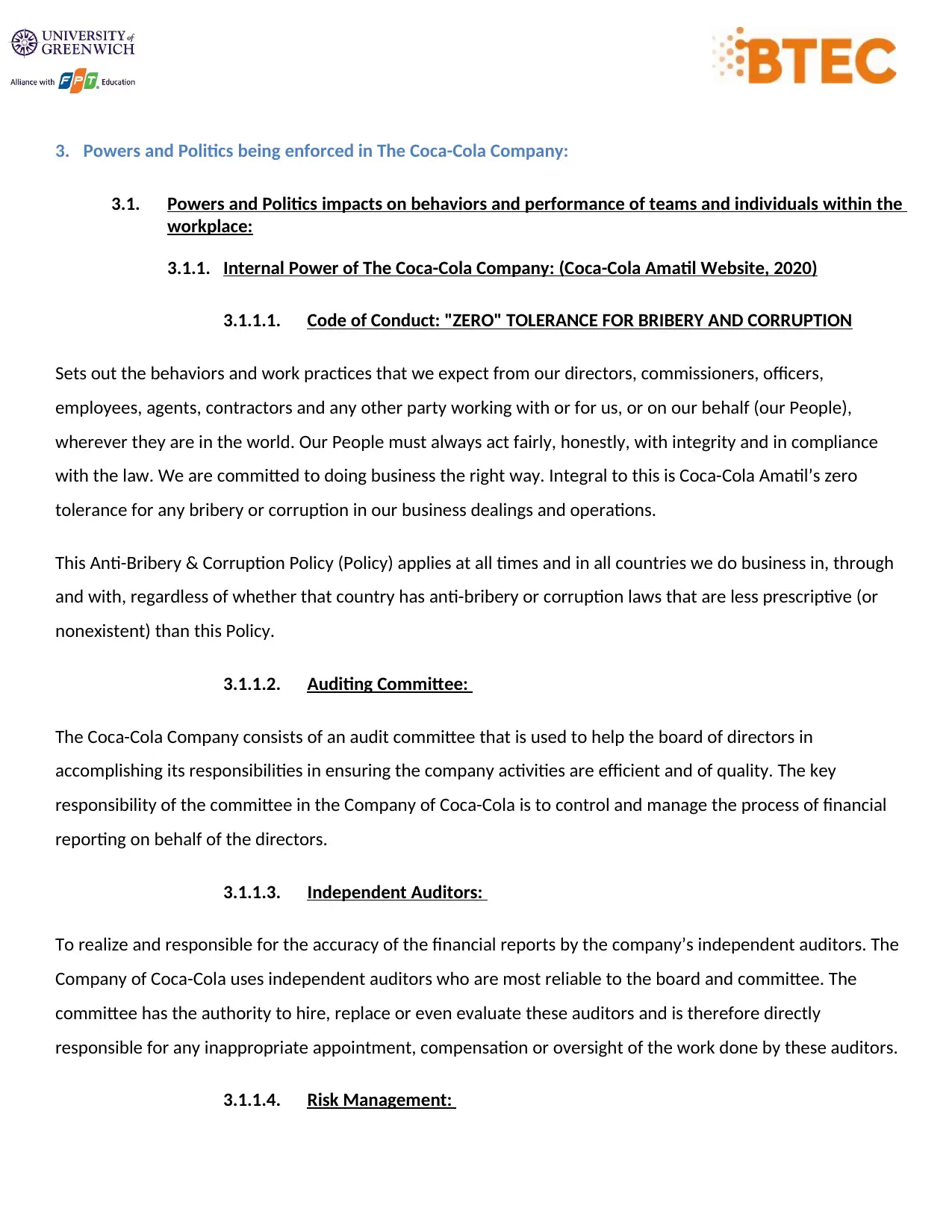
3. Powers and Politics being enforced in The Coca-Cola Company:
3.1. Powers and Politics impacts on behaviors and performance of teams and individuals within the
workplace:
3.1.1. Internal Power of The Coca-Cola Company: (Coca-Cola Amatil Website, 2020)
3.1.1.1. Code of Conduct: "ZERO" TOLERANCE FOR BRIBERY AND CORRUPTION
Sets out the behaviors and work practices that we expect from our directors, commissioners, officers,
employees, agents, contractors and any other party working with or for us, or on our behalf (our People),
wherever they are in the world. Our People must always act fairly, honestly, with integrity and in compliance
with the law. We are committed to doing business the right way. Integral to this is Coca-Cola Amatil’s zero
tolerance for any bribery or corruption in our business dealings and operations.
This Anti-Bribery & Corruption Policy (Policy) applies at all times and in all countries we do business in, through
and with, regardless of whether that country has anti-bribery or corruption laws that are less prescriptive (or
nonexistent) than this Policy.
3.1.1.2. Auditing Committee:
The Coca-Cola Company consists of an audit committee that is used to help the board of directors in
accomplishing its responsibilities in ensuring the company activities are efficient and of quality. The key
responsibility of the committee in the Company of Coca-Cola is to control and manage the process of financial
reporting on behalf of the directors.
3.1.1.3. Independent Auditors:
To realize and responsible for the accuracy of the financial reports by the company’s independent auditors. The
Company of Coca-Cola uses independent auditors who are most reliable to the board and committee. The
committee has the authority to hire, replace or even evaluate these auditors and is therefore directly
responsible for any inappropriate appointment, compensation or oversight of the work done by these auditors.
3.1.1.4. Risk Management:
3.1. Powers and Politics impacts on behaviors and performance of teams and individuals within the
workplace:
3.1.1. Internal Power of The Coca-Cola Company: (Coca-Cola Amatil Website, 2020)
3.1.1.1. Code of Conduct: "ZERO" TOLERANCE FOR BRIBERY AND CORRUPTION
Sets out the behaviors and work practices that we expect from our directors, commissioners, officers,
employees, agents, contractors and any other party working with or for us, or on our behalf (our People),
wherever they are in the world. Our People must always act fairly, honestly, with integrity and in compliance
with the law. We are committed to doing business the right way. Integral to this is Coca-Cola Amatil’s zero
tolerance for any bribery or corruption in our business dealings and operations.
This Anti-Bribery & Corruption Policy (Policy) applies at all times and in all countries we do business in, through
and with, regardless of whether that country has anti-bribery or corruption laws that are less prescriptive (or
nonexistent) than this Policy.
3.1.1.2. Auditing Committee:
The Coca-Cola Company consists of an audit committee that is used to help the board of directors in
accomplishing its responsibilities in ensuring the company activities are efficient and of quality. The key
responsibility of the committee in the Company of Coca-Cola is to control and manage the process of financial
reporting on behalf of the directors.
3.1.1.3. Independent Auditors:
To realize and responsible for the accuracy of the financial reports by the company’s independent auditors. The
Company of Coca-Cola uses independent auditors who are most reliable to the board and committee. The
committee has the authority to hire, replace or even evaluate these auditors and is therefore directly
responsible for any inappropriate appointment, compensation or oversight of the work done by these auditors.
3.1.1.4. Risk Management:
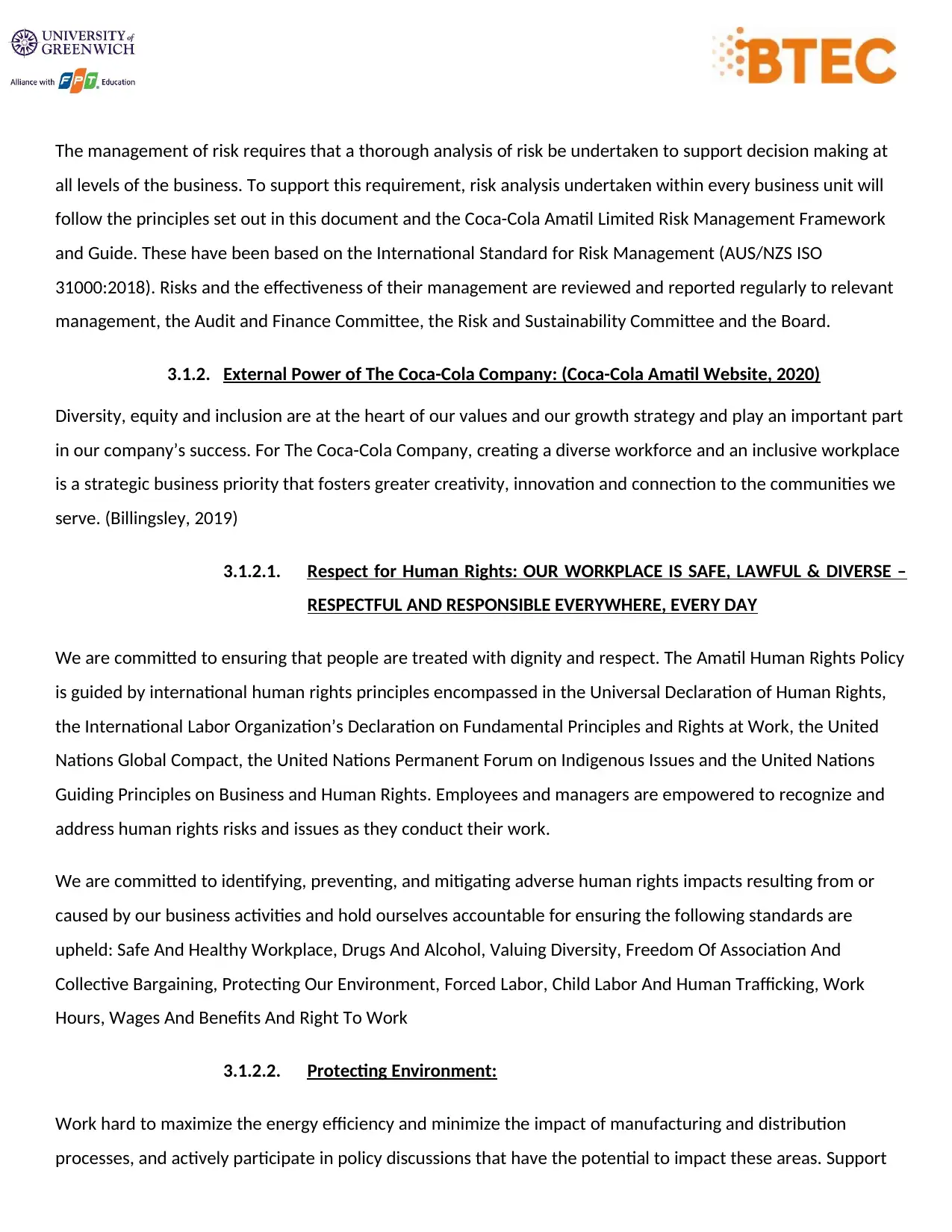
The management of risk requires that a thorough analysis of risk be undertaken to support decision making at
all levels of the business. To support this requirement, risk analysis undertaken within every business unit will
follow the principles set out in this document and the Coca-Cola Amatil Limited Risk Management Framework
and Guide. These have been based on the International Standard for Risk Management (AUS/NZS ISO
31000:2018). Risks and the effectiveness of their management are reviewed and reported regularly to relevant
management, the Audit and Finance Committee, the Risk and Sustainability Committee and the Board.
3.1.2. External Power of The Coca-Cola Company: (Coca-Cola Amatil Website, 2020)
Diversity, equity and inclusion are at the heart of our values and our growth strategy and play an important part
in our company’s success. For The Coca-Cola Company, creating a diverse workforce and an inclusive workplace
is a strategic business priority that fosters greater creativity, innovation and connection to the communities we
serve. (Billingsley, 2019)
3.1.2.1. Respect for Human Rights: OUR WORKPLACE IS SAFE, LAWFUL & DIVERSE –
RESPECTFUL AND RESPONSIBLE EVERYWHERE, EVERY DAY
We are committed to ensuring that people are treated with dignity and respect. The Amatil Human Rights Policy
is guided by international human rights principles encompassed in the Universal Declaration of Human Rights,
the International Labor Organization’s Declaration on Fundamental Principles and Rights at Work, the United
Nations Global Compact, the United Nations Permanent Forum on Indigenous Issues and the United Nations
Guiding Principles on Business and Human Rights. Employees and managers are empowered to recognize and
address human rights risks and issues as they conduct their work.
We are committed to identifying, preventing, and mitigating adverse human rights impacts resulting from or
caused by our business activities and hold ourselves accountable for ensuring the following standards are
upheld: Safe And Healthy Workplace, Drugs And Alcohol, Valuing Diversity, Freedom Of Association And
Collective Bargaining, Protecting Our Environment, Forced Labor, Child Labor And Human Trafficking, Work
Hours, Wages And Benefits And Right To Work
3.1.2.2. Protecting Environment:
Work hard to maximize the energy efficiency and minimize the impact of manufacturing and distribution
processes, and actively participate in policy discussions that have the potential to impact these areas. Support
all levels of the business. To support this requirement, risk analysis undertaken within every business unit will
follow the principles set out in this document and the Coca-Cola Amatil Limited Risk Management Framework
and Guide. These have been based on the International Standard for Risk Management (AUS/NZS ISO
31000:2018). Risks and the effectiveness of their management are reviewed and reported regularly to relevant
management, the Audit and Finance Committee, the Risk and Sustainability Committee and the Board.
3.1.2. External Power of The Coca-Cola Company: (Coca-Cola Amatil Website, 2020)
Diversity, equity and inclusion are at the heart of our values and our growth strategy and play an important part
in our company’s success. For The Coca-Cola Company, creating a diverse workforce and an inclusive workplace
is a strategic business priority that fosters greater creativity, innovation and connection to the communities we
serve. (Billingsley, 2019)
3.1.2.1. Respect for Human Rights: OUR WORKPLACE IS SAFE, LAWFUL & DIVERSE –
RESPECTFUL AND RESPONSIBLE EVERYWHERE, EVERY DAY
We are committed to ensuring that people are treated with dignity and respect. The Amatil Human Rights Policy
is guided by international human rights principles encompassed in the Universal Declaration of Human Rights,
the International Labor Organization’s Declaration on Fundamental Principles and Rights at Work, the United
Nations Global Compact, the United Nations Permanent Forum on Indigenous Issues and the United Nations
Guiding Principles on Business and Human Rights. Employees and managers are empowered to recognize and
address human rights risks and issues as they conduct their work.
We are committed to identifying, preventing, and mitigating adverse human rights impacts resulting from or
caused by our business activities and hold ourselves accountable for ensuring the following standards are
upheld: Safe And Healthy Workplace, Drugs And Alcohol, Valuing Diversity, Freedom Of Association And
Collective Bargaining, Protecting Our Environment, Forced Labor, Child Labor And Human Trafficking, Work
Hours, Wages And Benefits And Right To Work
3.1.2.2. Protecting Environment:
Work hard to maximize the energy efficiency and minimize the impact of manufacturing and distribution
processes, and actively participate in policy discussions that have the potential to impact these areas. Support
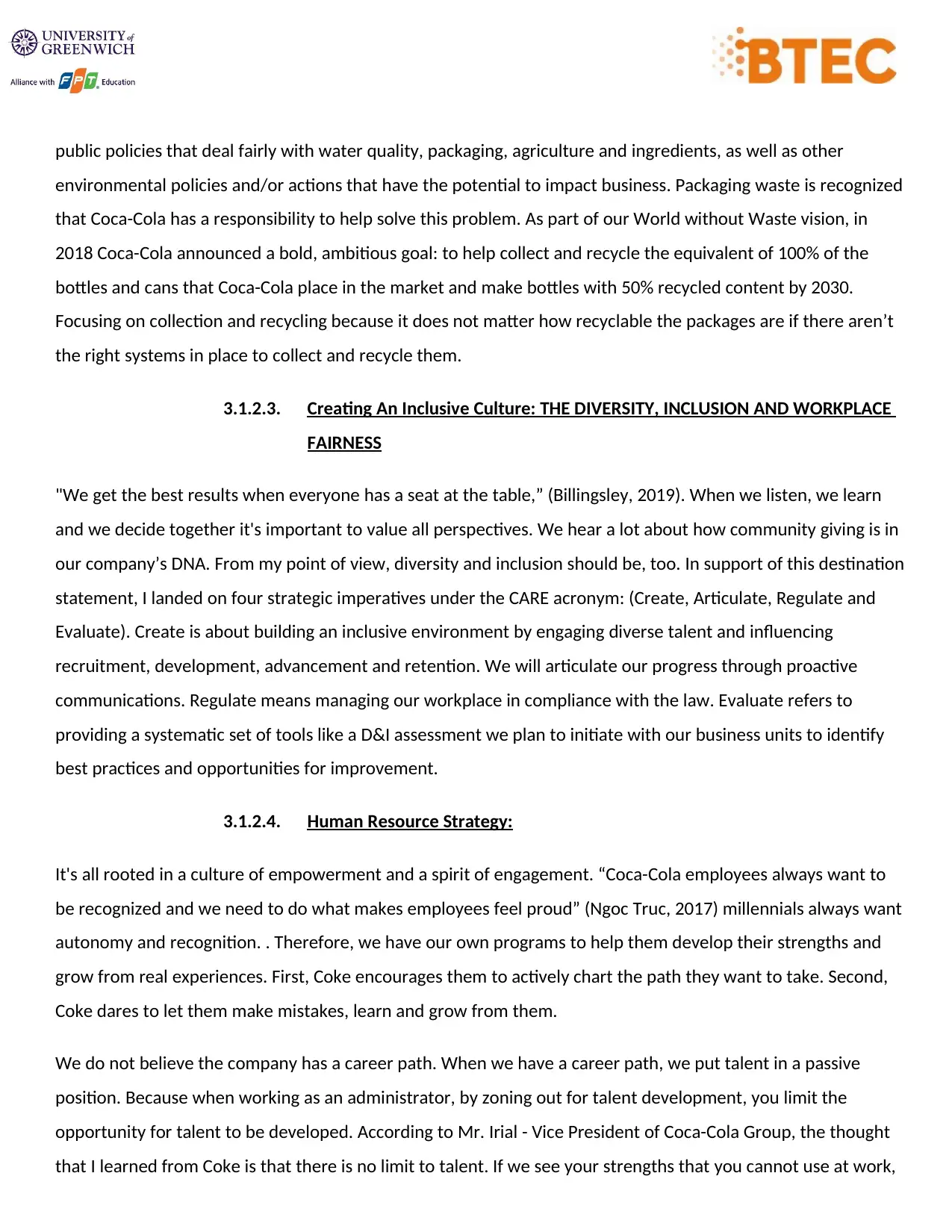
public policies that deal fairly with water quality, packaging, agriculture and ingredients, as well as other
environmental policies and/or actions that have the potential to impact business. Packaging waste is recognized
that Coca-Cola has a responsibility to help solve this problem. As part of our World without Waste vision, in
2018 Coca-Cola announced a bold, ambitious goal: to help collect and recycle the equivalent of 100% of the
bottles and cans that Coca-Cola place in the market and make bottles with 50% recycled content by 2030.
Focusing on collection and recycling because it does not matter how recyclable the packages are if there aren’t
the right systems in place to collect and recycle them.
3.1.2.3. Creating An Inclusive Culture: THE DIVERSITY, INCLUSION AND WORKPLACE
FAIRNESS
"We get the best results when everyone has a seat at the table,” (Billingsley, 2019). When we listen, we learn
and we decide together it's important to value all perspectives. We hear a lot about how community giving is in
our company’s DNA. From my point of view, diversity and inclusion should be, too. In support of this destination
statement, I landed on four strategic imperatives under the CARE acronym: (Create, Articulate, Regulate and
Evaluate). Create is about building an inclusive environment by engaging diverse talent and influencing
recruitment, development, advancement and retention. We will articulate our progress through proactive
communications. Regulate means managing our workplace in compliance with the law. Evaluate refers to
providing a systematic set of tools like a D&I assessment we plan to initiate with our business units to identify
best practices and opportunities for improvement.
3.1.2.4. Human Resource Strategy:
It's all rooted in a culture of empowerment and a spirit of engagement. “Coca-Cola employees always want to
be recognized and we need to do what makes employees feel proud” (Ngoc Truc, 2017) millennials always want
autonomy and recognition. . Therefore, we have our own programs to help them develop their strengths and
grow from real experiences. First, Coke encourages them to actively chart the path they want to take. Second,
Coke dares to let them make mistakes, learn and grow from them.
We do not believe the company has a career path. When we have a career path, we put talent in a passive
position. Because when working as an administrator, by zoning out for talent development, you limit the
opportunity for talent to be developed. According to Mr. Irial - Vice President of Coca-Cola Group, the thought
that I learned from Coke is that there is no limit to talent. If we see your strengths that you cannot use at work,
environmental policies and/or actions that have the potential to impact business. Packaging waste is recognized
that Coca-Cola has a responsibility to help solve this problem. As part of our World without Waste vision, in
2018 Coca-Cola announced a bold, ambitious goal: to help collect and recycle the equivalent of 100% of the
bottles and cans that Coca-Cola place in the market and make bottles with 50% recycled content by 2030.
Focusing on collection and recycling because it does not matter how recyclable the packages are if there aren’t
the right systems in place to collect and recycle them.
3.1.2.3. Creating An Inclusive Culture: THE DIVERSITY, INCLUSION AND WORKPLACE
FAIRNESS
"We get the best results when everyone has a seat at the table,” (Billingsley, 2019). When we listen, we learn
and we decide together it's important to value all perspectives. We hear a lot about how community giving is in
our company’s DNA. From my point of view, diversity and inclusion should be, too. In support of this destination
statement, I landed on four strategic imperatives under the CARE acronym: (Create, Articulate, Regulate and
Evaluate). Create is about building an inclusive environment by engaging diverse talent and influencing
recruitment, development, advancement and retention. We will articulate our progress through proactive
communications. Regulate means managing our workplace in compliance with the law. Evaluate refers to
providing a systematic set of tools like a D&I assessment we plan to initiate with our business units to identify
best practices and opportunities for improvement.
3.1.2.4. Human Resource Strategy:
It's all rooted in a culture of empowerment and a spirit of engagement. “Coca-Cola employees always want to
be recognized and we need to do what makes employees feel proud” (Ngoc Truc, 2017) millennials always want
autonomy and recognition. . Therefore, we have our own programs to help them develop their strengths and
grow from real experiences. First, Coke encourages them to actively chart the path they want to take. Second,
Coke dares to let them make mistakes, learn and grow from them.
We do not believe the company has a career path. When we have a career path, we put talent in a passive
position. Because when working as an administrator, by zoning out for talent development, you limit the
opportunity for talent to be developed. According to Mr. Irial - Vice President of Coca-Cola Group, the thought
that I learned from Coke is that there is no limit to talent. If we see your strengths that you cannot use at work,
Secure Best Marks with AI Grader
Need help grading? Try our AI Grader for instant feedback on your assignments.
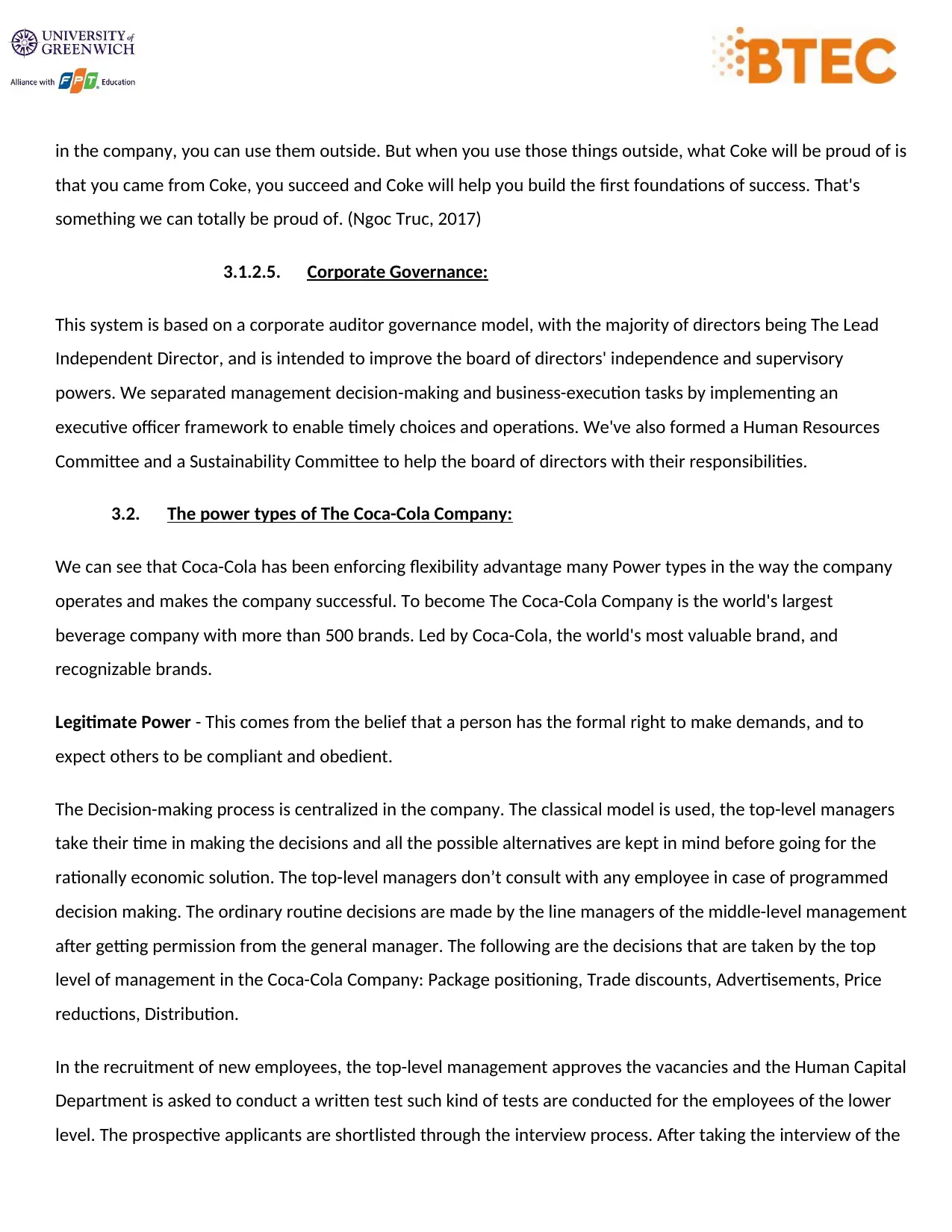
in the company, you can use them outside. But when you use those things outside, what Coke will be proud of is
that you came from Coke, you succeed and Coke will help you build the first foundations of success. That's
something we can totally be proud of. (Ngoc Truc, 2017)
3.1.2.5. Corporate Governance:
This system is based on a corporate auditor governance model, with the majority of directors being The Lead
Independent Director, and is intended to improve the board of directors' independence and supervisory
powers. We separated management decision-making and business-execution tasks by implementing an
executive officer framework to enable timely choices and operations. We've also formed a Human Resources
Committee and a Sustainability Committee to help the board of directors with their responsibilities.
3.2. The power types of The Coca-Cola Company:
We can see that Coca-Cola has been enforcing flexibility advantage many Power types in the way the company
operates and makes the company successful. To become The Coca-Cola Company is the world's largest
beverage company with more than 500 brands. Led by Coca-Cola, the world's most valuable brand, and
recognizable brands.
Legitimate Power - This comes from the belief that a person has the formal right to make demands, and to
expect others to be compliant and obedient.
The Decision-making process is centralized in the company. The classical model is used, the top-level managers
take their time in making the decisions and all the possible alternatives are kept in mind before going for the
rationally economic solution. The top-level managers don’t consult with any employee in case of programmed
decision making. The ordinary routine decisions are made by the line managers of the middle-level management
after getting permission from the general manager. The following are the decisions that are taken by the top
level of management in the Coca-Cola Company: Package positioning, Trade discounts, Advertisements, Price
reductions, Distribution.
In the recruitment of new employees, the top-level management approves the vacancies and the Human Capital
Department is asked to conduct a written test such kind of tests are conducted for the employees of the lower
level. The prospective applicants are shortlisted through the interview process. After taking the interview of the
that you came from Coke, you succeed and Coke will help you build the first foundations of success. That's
something we can totally be proud of. (Ngoc Truc, 2017)
3.1.2.5. Corporate Governance:
This system is based on a corporate auditor governance model, with the majority of directors being The Lead
Independent Director, and is intended to improve the board of directors' independence and supervisory
powers. We separated management decision-making and business-execution tasks by implementing an
executive officer framework to enable timely choices and operations. We've also formed a Human Resources
Committee and a Sustainability Committee to help the board of directors with their responsibilities.
3.2. The power types of The Coca-Cola Company:
We can see that Coca-Cola has been enforcing flexibility advantage many Power types in the way the company
operates and makes the company successful. To become The Coca-Cola Company is the world's largest
beverage company with more than 500 brands. Led by Coca-Cola, the world's most valuable brand, and
recognizable brands.
Legitimate Power - This comes from the belief that a person has the formal right to make demands, and to
expect others to be compliant and obedient.
The Decision-making process is centralized in the company. The classical model is used, the top-level managers
take their time in making the decisions and all the possible alternatives are kept in mind before going for the
rationally economic solution. The top-level managers don’t consult with any employee in case of programmed
decision making. The ordinary routine decisions are made by the line managers of the middle-level management
after getting permission from the general manager. The following are the decisions that are taken by the top
level of management in the Coca-Cola Company: Package positioning, Trade discounts, Advertisements, Price
reductions, Distribution.
In the recruitment of new employees, the top-level management approves the vacancies and the Human Capital
Department is asked to conduct a written test such kind of tests are conducted for the employees of the lower
level. The prospective applicants are shortlisted through the interview process. After taking the interview of the
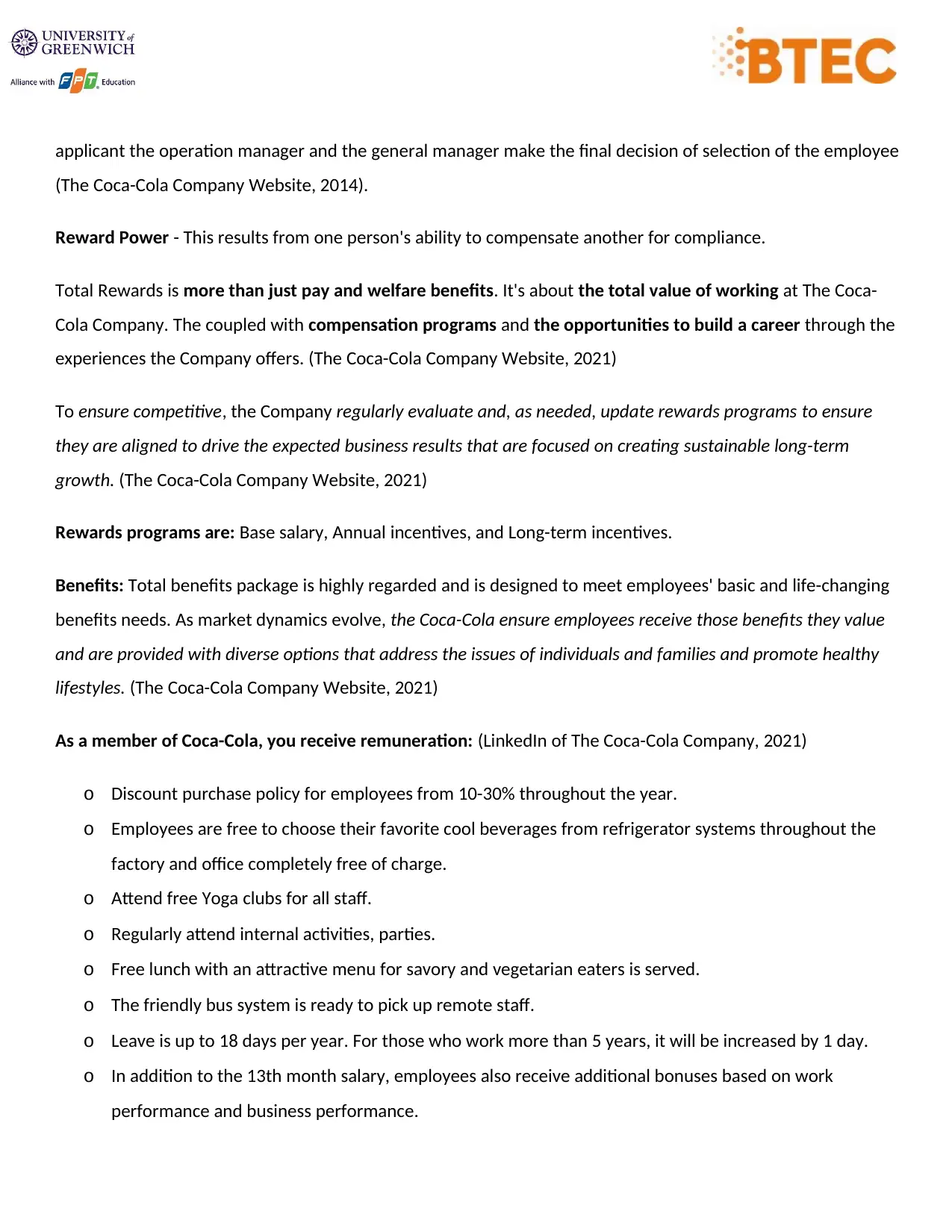
applicant the operation manager and the general manager make the final decision of selection of the employee
(The Coca-Cola Company Website, 2014).
Reward Power - This results from one person's ability to compensate another for compliance.
Total Rewards is more than just pay and welfare benefits. It's about the total value of working at The Coca-
Cola Company. The coupled with compensation programs and the opportunities to build a career through the
experiences the Company offers. (The Coca-Cola Company Website, 2021)
To ensure competitive, the Company regularly evaluate and, as needed, update rewards programs to ensure
they are aligned to drive the expected business results that are focused on creating sustainable long-term
growth. (The Coca-Cola Company Website, 2021)
Rewards programs are: Base salary, Annual incentives, and Long-term incentives.
Benefits: Total benefits package is highly regarded and is designed to meet employees' basic and life-changing
benefits needs. As market dynamics evolve, the Coca-Cola ensure employees receive those benefits they value
and are provided with diverse options that address the issues of individuals and families and promote healthy
lifestyles. (The Coca-Cola Company Website, 2021)
As a member of Coca-Cola, you receive remuneration: (LinkedIn of The Coca-Cola Company, 2021)
o Discount purchase policy for employees from 10-30% throughout the year.
o Employees are free to choose their favorite cool beverages from refrigerator systems throughout the
factory and office completely free of charge.
o Attend free Yoga clubs for all staff.
o Regularly attend internal activities, parties.
o Free lunch with an attractive menu for savory and vegetarian eaters is served.
o The friendly bus system is ready to pick up remote staff.
o Leave is up to 18 days per year. For those who work more than 5 years, it will be increased by 1 day.
o In addition to the 13th month salary, employees also receive additional bonuses based on work
performance and business performance.
(The Coca-Cola Company Website, 2014).
Reward Power - This results from one person's ability to compensate another for compliance.
Total Rewards is more than just pay and welfare benefits. It's about the total value of working at The Coca-
Cola Company. The coupled with compensation programs and the opportunities to build a career through the
experiences the Company offers. (The Coca-Cola Company Website, 2021)
To ensure competitive, the Company regularly evaluate and, as needed, update rewards programs to ensure
they are aligned to drive the expected business results that are focused on creating sustainable long-term
growth. (The Coca-Cola Company Website, 2021)
Rewards programs are: Base salary, Annual incentives, and Long-term incentives.
Benefits: Total benefits package is highly regarded and is designed to meet employees' basic and life-changing
benefits needs. As market dynamics evolve, the Coca-Cola ensure employees receive those benefits they value
and are provided with diverse options that address the issues of individuals and families and promote healthy
lifestyles. (The Coca-Cola Company Website, 2021)
As a member of Coca-Cola, you receive remuneration: (LinkedIn of The Coca-Cola Company, 2021)
o Discount purchase policy for employees from 10-30% throughout the year.
o Employees are free to choose their favorite cool beverages from refrigerator systems throughout the
factory and office completely free of charge.
o Attend free Yoga clubs for all staff.
o Regularly attend internal activities, parties.
o Free lunch with an attractive menu for savory and vegetarian eaters is served.
o The friendly bus system is ready to pick up remote staff.
o Leave is up to 18 days per year. For those who work more than 5 years, it will be increased by 1 day.
o In addition to the 13th month salary, employees also receive additional bonuses based on work
performance and business performance.
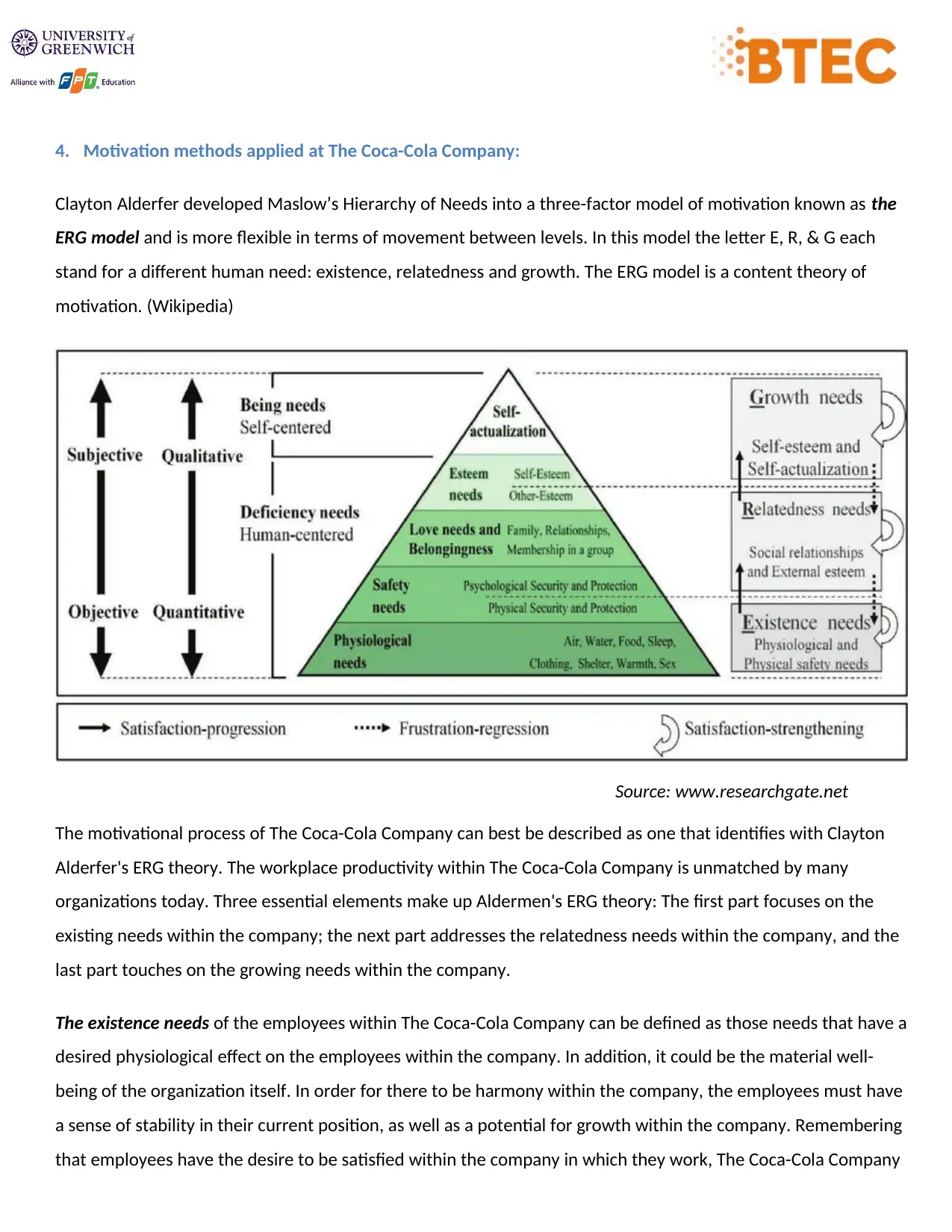
4. Motivation methods applied at The Coca-Cola Company:
Clayton Alderfer developed Maslow’s Hierarchy of Needs into a three-factor model of motivation known as the
ERG model and is more flexible in terms of movement between levels. In this model the letter E, R, & G each
stand for a different human need: existence, relatedness and growth. The ERG model is a content theory of
motivation. (Wikipedia)
Source: www.researchgate.net
The motivational process of The Coca-Cola Company can best be described as one that identifies with Clayton
Alderfer's ERG theory. The workplace productivity within The Coca-Cola Company is unmatched by many
organizations today. Three essential elements make up Aldermen's ERG theory: The first part focuses on the
existing needs within the company; the next part addresses the relatedness needs within the company, and the
last part touches on the growing needs within the company.
The existence needs of the employees within The Coca-Cola Company can be defined as those needs that have a
desired physiological effect on the employees within the company. In addition, it could be the material well-
being of the organization itself. In order for there to be harmony within the company, the employees must have
a sense of stability in their current position, as well as a potential for growth within the company. Remembering
that employees have the desire to be satisfied within the company in which they work, The Coca-Cola Company
Clayton Alderfer developed Maslow’s Hierarchy of Needs into a three-factor model of motivation known as the
ERG model and is more flexible in terms of movement between levels. In this model the letter E, R, & G each
stand for a different human need: existence, relatedness and growth. The ERG model is a content theory of
motivation. (Wikipedia)
Source: www.researchgate.net
The motivational process of The Coca-Cola Company can best be described as one that identifies with Clayton
Alderfer's ERG theory. The workplace productivity within The Coca-Cola Company is unmatched by many
organizations today. Three essential elements make up Aldermen's ERG theory: The first part focuses on the
existing needs within the company; the next part addresses the relatedness needs within the company, and the
last part touches on the growing needs within the company.
The existence needs of the employees within The Coca-Cola Company can be defined as those needs that have a
desired physiological effect on the employees within the company. In addition, it could be the material well-
being of the organization itself. In order for there to be harmony within the company, the employees must have
a sense of stability in their current position, as well as a potential for growth within the company. Remembering
that employees have the desire to be satisfied within the company in which they work, The Coca-Cola Company
Paraphrase This Document
Need a fresh take? Get an instant paraphrase of this document with our AI Paraphraser
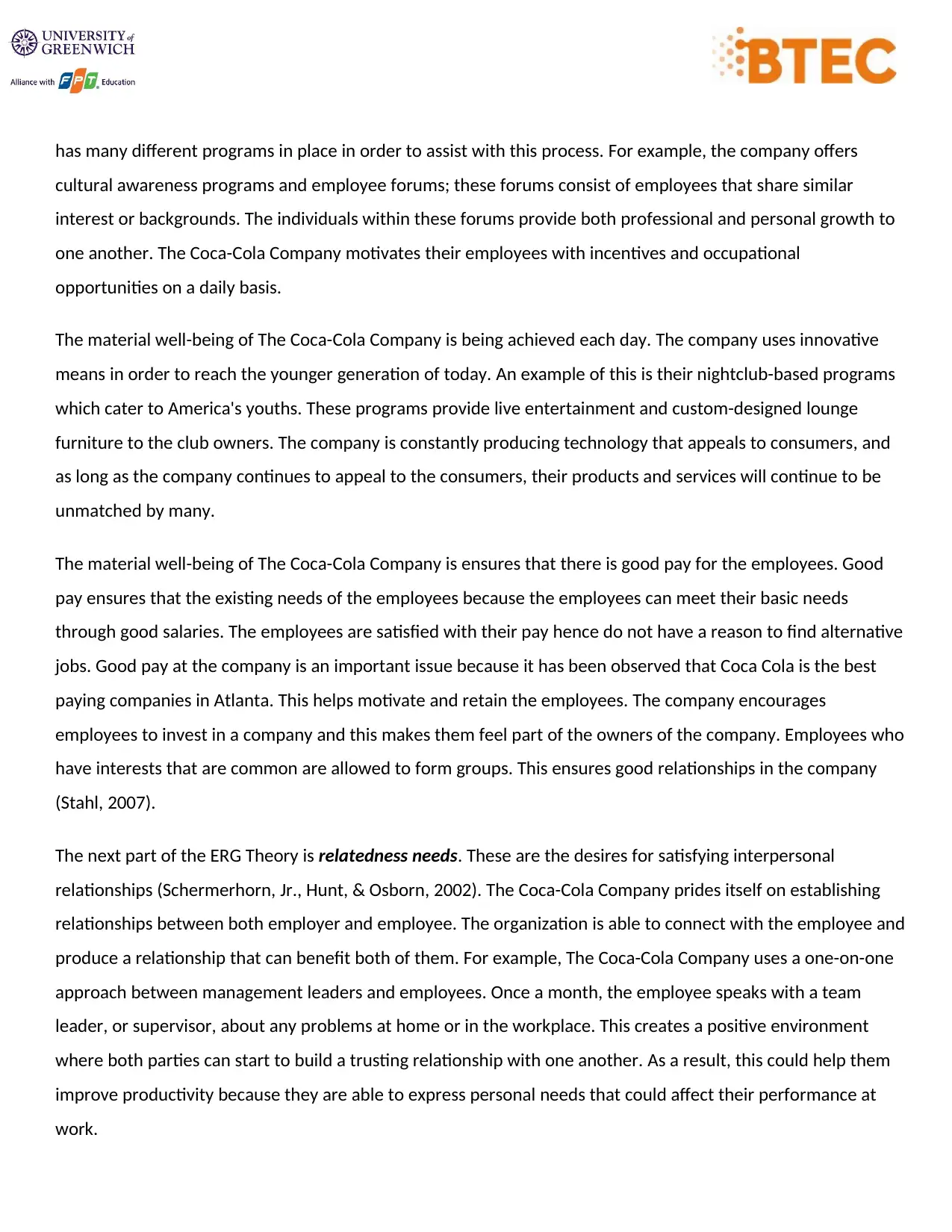
has many different programs in place in order to assist with this process. For example, the company offers
cultural awareness programs and employee forums; these forums consist of employees that share similar
interest or backgrounds. The individuals within these forums provide both professional and personal growth to
one another. The Coca-Cola Company motivates their employees with incentives and occupational
opportunities on a daily basis.
The material well-being of The Coca-Cola Company is being achieved each day. The company uses innovative
means in order to reach the younger generation of today. An example of this is their nightclub-based programs
which cater to America's youths. These programs provide live entertainment and custom-designed lounge
furniture to the club owners. The company is constantly producing technology that appeals to consumers, and
as long as the company continues to appeal to the consumers, their products and services will continue to be
unmatched by many.
The material well-being of The Coca-Cola Company is ensures that there is good pay for the employees. Good
pay ensures that the existing needs of the employees because the employees can meet their basic needs
through good salaries. The employees are satisfied with their pay hence do not have a reason to find alternative
jobs. Good pay at the company is an important issue because it has been observed that Coca Cola is the best
paying companies in Atlanta. This helps motivate and retain the employees. The company encourages
employees to invest in a company and this makes them feel part of the owners of the company. Employees who
have interests that are common are allowed to form groups. This ensures good relationships in the company
(Stahl, 2007).
The next part of the ERG Theory is relatedness needs. These are the desires for satisfying interpersonal
relationships (Schermerhorn, Jr., Hunt, & Osborn, 2002). The Coca-Cola Company prides itself on establishing
relationships between both employer and employee. The organization is able to connect with the employee and
produce a relationship that can benefit both of them. For example, The Coca-Cola Company uses a one-on-one
approach between management leaders and employees. Once a month, the employee speaks with a team
leader, or supervisor, about any problems at home or in the workplace. This creates a positive environment
where both parties can start to build a trusting relationship with one another. As a result, this could help them
improve productivity because they are able to express personal needs that could affect their performance at
work.
cultural awareness programs and employee forums; these forums consist of employees that share similar
interest or backgrounds. The individuals within these forums provide both professional and personal growth to
one another. The Coca-Cola Company motivates their employees with incentives and occupational
opportunities on a daily basis.
The material well-being of The Coca-Cola Company is being achieved each day. The company uses innovative
means in order to reach the younger generation of today. An example of this is their nightclub-based programs
which cater to America's youths. These programs provide live entertainment and custom-designed lounge
furniture to the club owners. The company is constantly producing technology that appeals to consumers, and
as long as the company continues to appeal to the consumers, their products and services will continue to be
unmatched by many.
The material well-being of The Coca-Cola Company is ensures that there is good pay for the employees. Good
pay ensures that the existing needs of the employees because the employees can meet their basic needs
through good salaries. The employees are satisfied with their pay hence do not have a reason to find alternative
jobs. Good pay at the company is an important issue because it has been observed that Coca Cola is the best
paying companies in Atlanta. This helps motivate and retain the employees. The company encourages
employees to invest in a company and this makes them feel part of the owners of the company. Employees who
have interests that are common are allowed to form groups. This ensures good relationships in the company
(Stahl, 2007).
The next part of the ERG Theory is relatedness needs. These are the desires for satisfying interpersonal
relationships (Schermerhorn, Jr., Hunt, & Osborn, 2002). The Coca-Cola Company prides itself on establishing
relationships between both employer and employee. The organization is able to connect with the employee and
produce a relationship that can benefit both of them. For example, The Coca-Cola Company uses a one-on-one
approach between management leaders and employees. Once a month, the employee speaks with a team
leader, or supervisor, about any problems at home or in the workplace. This creates a positive environment
where both parties can start to build a trusting relationship with one another. As a result, this could help them
improve productivity because they are able to express personal needs that could affect their performance at
work.
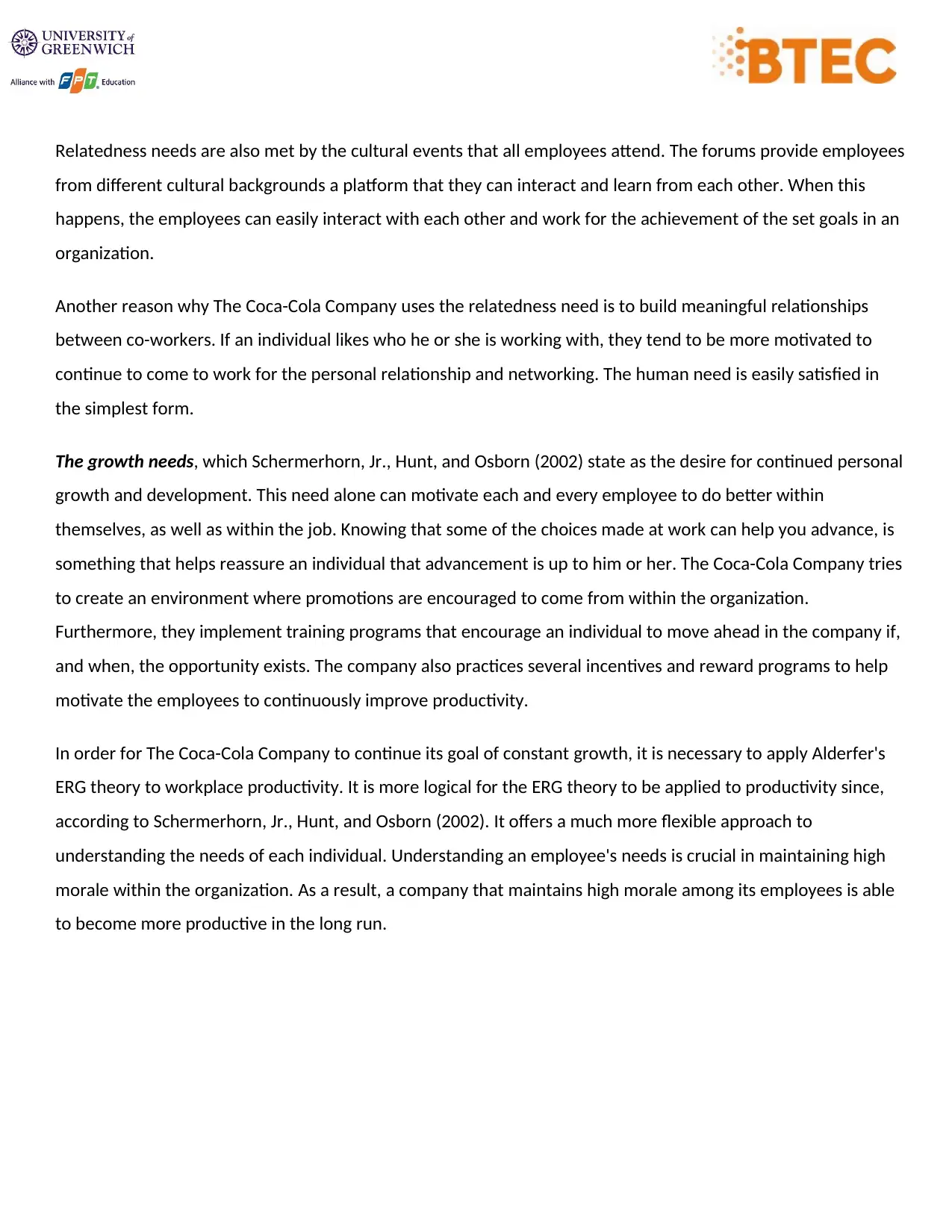
Relatedness needs are also met by the cultural events that all employees attend. The forums provide employees
from different cultural backgrounds a platform that they can interact and learn from each other. When this
happens, the employees can easily interact with each other and work for the achievement of the set goals in an
organization.
Another reason why The Coca-Cola Company uses the relatedness need is to build meaningful relationships
between co-workers. If an individual likes who he or she is working with, they tend to be more motivated to
continue to come to work for the personal relationship and networking. The human need is easily satisfied in
the simplest form.
The growth needs, which Schermerhorn, Jr., Hunt, and Osborn (2002) state as the desire for continued personal
growth and development. This need alone can motivate each and every employee to do better within
themselves, as well as within the job. Knowing that some of the choices made at work can help you advance, is
something that helps reassure an individual that advancement is up to him or her. The Coca-Cola Company tries
to create an environment where promotions are encouraged to come from within the organization.
Furthermore, they implement training programs that encourage an individual to move ahead in the company if,
and when, the opportunity exists. The company also practices several incentives and reward programs to help
motivate the employees to continuously improve productivity.
In order for The Coca-Cola Company to continue its goal of constant growth, it is necessary to apply Alderfer's
ERG theory to workplace productivity. It is more logical for the ERG theory to be applied to productivity since,
according to Schermerhorn, Jr., Hunt, and Osborn (2002). It offers a much more flexible approach to
understanding the needs of each individual. Understanding an employee's needs is crucial in maintaining high
morale within the organization. As a result, a company that maintains high morale among its employees is able
to become more productive in the long run.
from different cultural backgrounds a platform that they can interact and learn from each other. When this
happens, the employees can easily interact with each other and work for the achievement of the set goals in an
organization.
Another reason why The Coca-Cola Company uses the relatedness need is to build meaningful relationships
between co-workers. If an individual likes who he or she is working with, they tend to be more motivated to
continue to come to work for the personal relationship and networking. The human need is easily satisfied in
the simplest form.
The growth needs, which Schermerhorn, Jr., Hunt, and Osborn (2002) state as the desire for continued personal
growth and development. This need alone can motivate each and every employee to do better within
themselves, as well as within the job. Knowing that some of the choices made at work can help you advance, is
something that helps reassure an individual that advancement is up to him or her. The Coca-Cola Company tries
to create an environment where promotions are encouraged to come from within the organization.
Furthermore, they implement training programs that encourage an individual to move ahead in the company if,
and when, the opportunity exists. The company also practices several incentives and reward programs to help
motivate the employees to continuously improve productivity.
In order for The Coca-Cola Company to continue its goal of constant growth, it is necessary to apply Alderfer's
ERG theory to workplace productivity. It is more logical for the ERG theory to be applied to productivity since,
according to Schermerhorn, Jr., Hunt, and Osborn (2002). It offers a much more flexible approach to
understanding the needs of each individual. Understanding an employee's needs is crucial in maintaining high
morale within the organization. As a result, a company that maintains high morale among its employees is able
to become more productive in the long run.
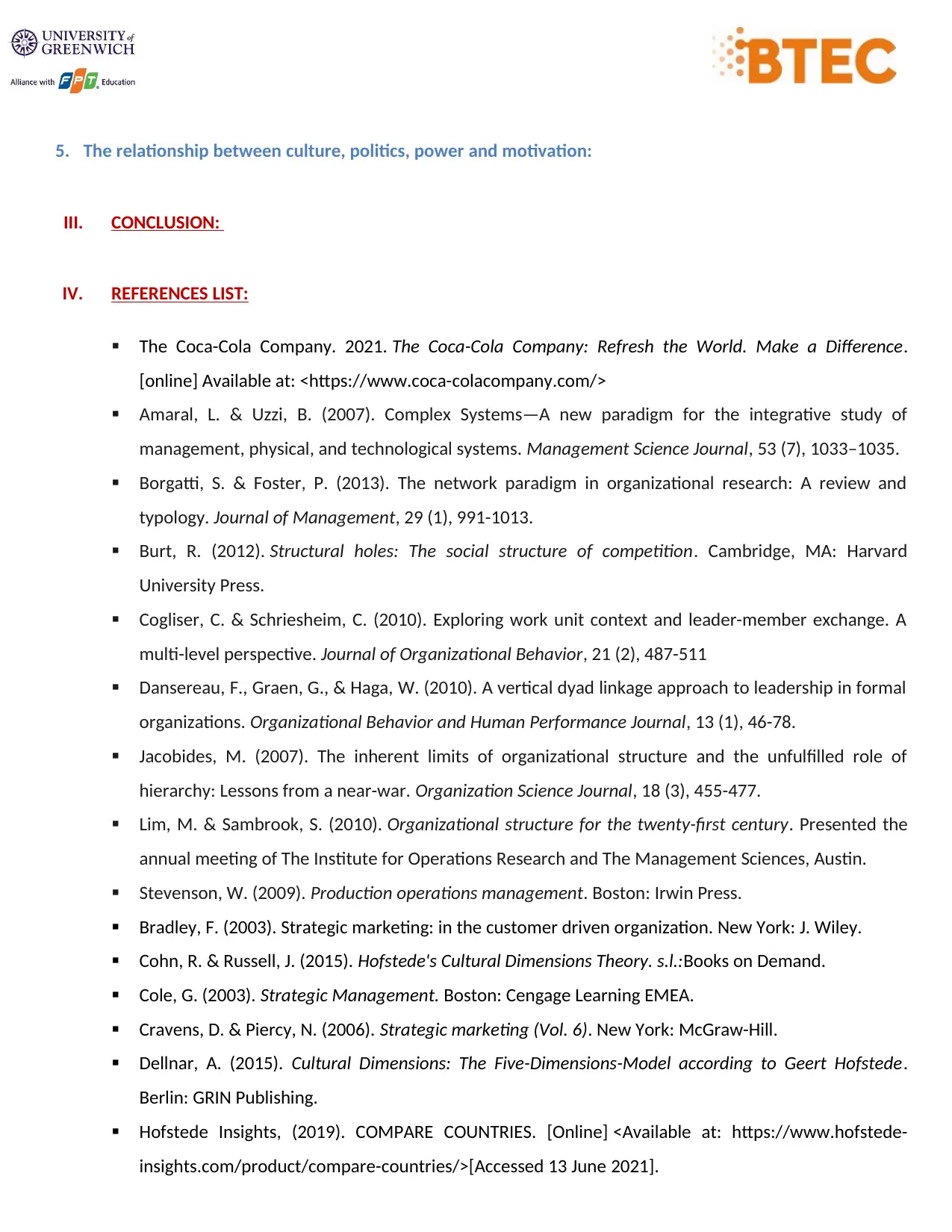
5. The relationship between culture, politics, power and motivation:
III. CONCLUSION:
IV. REFERENCES LIST:
The Coca-Cola Company. 2021. The Coca-Cola Company: Refresh the World. Make a Difference.
[online] Available at: <https://www.coca-colacompany.com/>
Amaral, L. & Uzzi, B. (2007). Complex Systems—A new paradigm for the integrative study of
management, physical, and technological systems. Management Science Journal, 53 (7), 1033–1035.
Borgatti, S. & Foster, P. (2013). The network paradigm in organizational research: A review and
typology. Journal of Management, 29 (1), 991-1013.
Burt, R. (2012). Structural holes: The social structure of competition. Cambridge, MA: Harvard
University Press.
Cogliser, C. & Schriesheim, C. (2010). Exploring work unit context and leader-member exchange. A
multi-level perspective. Journal of Organizational Behavior, 21 (2), 487-511
Dansereau, F., Graen, G., & Haga, W. (2010). A vertical dyad linkage approach to leadership in formal
organizations. Organizational Behavior and Human Performance Journal, 13 (1), 46-78.
Jacobides, M. (2007). The inherent limits of organizational structure and the unfulfilled role of
hierarchy: Lessons from a near-war. Organization Science Journal, 18 (3), 455-477.
Lim, M. & Sambrook, S. (2010). Organizational structure for the twenty-first century. Presented the
annual meeting of The Institute for Operations Research and The Management Sciences, Austin.
Stevenson, W. (2009). Production operations management. Boston: Irwin Press.
Bradley, F. (2003). Strategic marketing: in the customer driven organization. New York: J. Wiley.
Cohn, R. & Russell, J. (2015). Hofstede's Cultural Dimensions Theory. s.l.:Books on Demand.
Cole, G. (2003). Strategic Management. Boston: Cengage Learning EMEA.
Cravens, D. & Piercy, N. (2006). Strategic marketing (Vol. 6). New York: McGraw-Hill.
Dellnar, A. (2015). Cultural Dimensions: The Five-Dimensions-Model according to Geert Hofstede.
Berlin: GRIN Publishing.
Hofstede Insights, (2019). COMPARE COUNTRIES. [Online] <Available at: https://www.hofstede-
insights.com/product/compare-countries/>[Accessed 13 June 2021].
III. CONCLUSION:
IV. REFERENCES LIST:
The Coca-Cola Company. 2021. The Coca-Cola Company: Refresh the World. Make a Difference.
[online] Available at: <https://www.coca-colacompany.com/>
Amaral, L. & Uzzi, B. (2007). Complex Systems—A new paradigm for the integrative study of
management, physical, and technological systems. Management Science Journal, 53 (7), 1033–1035.
Borgatti, S. & Foster, P. (2013). The network paradigm in organizational research: A review and
typology. Journal of Management, 29 (1), 991-1013.
Burt, R. (2012). Structural holes: The social structure of competition. Cambridge, MA: Harvard
University Press.
Cogliser, C. & Schriesheim, C. (2010). Exploring work unit context and leader-member exchange. A
multi-level perspective. Journal of Organizational Behavior, 21 (2), 487-511
Dansereau, F., Graen, G., & Haga, W. (2010). A vertical dyad linkage approach to leadership in formal
organizations. Organizational Behavior and Human Performance Journal, 13 (1), 46-78.
Jacobides, M. (2007). The inherent limits of organizational structure and the unfulfilled role of
hierarchy: Lessons from a near-war. Organization Science Journal, 18 (3), 455-477.
Lim, M. & Sambrook, S. (2010). Organizational structure for the twenty-first century. Presented the
annual meeting of The Institute for Operations Research and The Management Sciences, Austin.
Stevenson, W. (2009). Production operations management. Boston: Irwin Press.
Bradley, F. (2003). Strategic marketing: in the customer driven organization. New York: J. Wiley.
Cohn, R. & Russell, J. (2015). Hofstede's Cultural Dimensions Theory. s.l.:Books on Demand.
Cole, G. (2003). Strategic Management. Boston: Cengage Learning EMEA.
Cravens, D. & Piercy, N. (2006). Strategic marketing (Vol. 6). New York: McGraw-Hill.
Dellnar, A. (2015). Cultural Dimensions: The Five-Dimensions-Model according to Geert Hofstede.
Berlin: GRIN Publishing.
Hofstede Insights, (2019). COMPARE COUNTRIES. [Online] <Available at: https://www.hofstede-
insights.com/product/compare-countries/>[Accessed 13 June 2021].
Secure Best Marks with AI Grader
Need help grading? Try our AI Grader for instant feedback on your assignments.
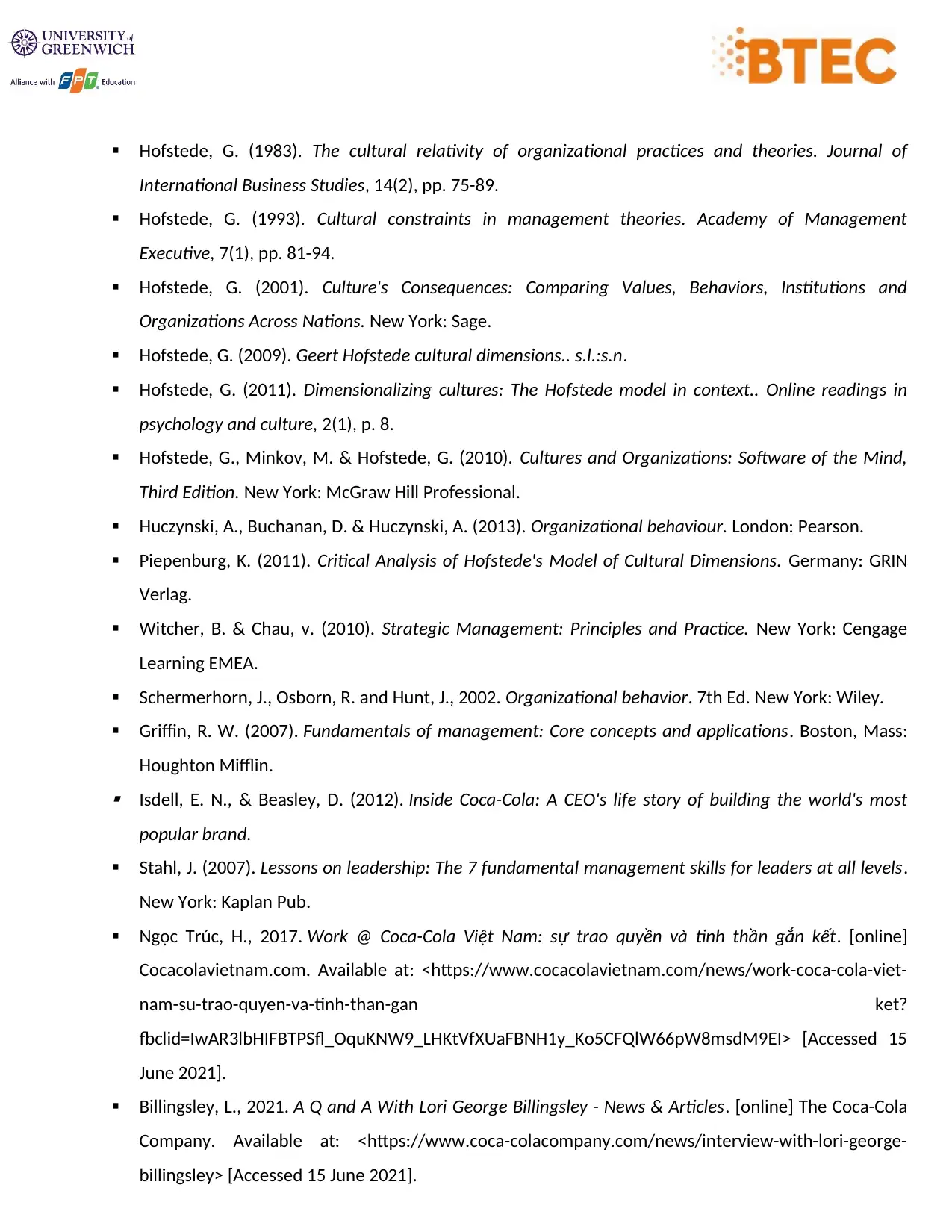
Hofstede, G. (1983). The cultural relativity of organizational practices and theories. Journal of
International Business Studies, 14(2), pp. 75-89.
Hofstede, G. (1993). Cultural constraints in management theories. Academy of Management
Executive, 7(1), pp. 81-94.
Hofstede, G. (2001). Culture's Consequences: Comparing Values, Behaviors, Institutions and
Organizations Across Nations. New York: Sage.
Hofstede, G. (2009). Geert Hofstede cultural dimensions.. s.l.:s.n.
Hofstede, G. (2011). Dimensionalizing cultures: The Hofstede model in context.. Online readings in
psychology and culture, 2(1), p. 8.
Hofstede, G., Minkov, M. & Hofstede, G. (2010). Cultures and Organizations: Software of the Mind,
Third Edition. New York: McGraw Hill Professional.
Huczynski, A., Buchanan, D. & Huczynski, A. (2013). Organizational behaviour. London: Pearson.
Piepenburg, K. (2011). Critical Analysis of Hofstede's Model of Cultural Dimensions. Germany: GRIN
Verlag.
Witcher, B. & Chau, v. (2010). Strategic Management: Principles and Practice. New York: Cengage
Learning EMEA.
Schermerhorn, J., Osborn, R. and Hunt, J., 2002. Organizational behavior. 7th Ed. New York: Wiley.
Griffin, R. W. (2007). Fundamentals of management: Core concepts and applications. Boston, Mass:
Houghton Mifflin. Isdell, E. N., & Beasley, D. (2012). Inside Coca-Cola: A CEO's life story of building the world's most
popular brand.
Stahl, J. (2007). Lessons on leadership: The 7 fundamental management skills for leaders at all levels.
New York: Kaplan Pub.
Ngọc Trúc, H., 2017. Work @ Coca-Cola Việt Nam: sự trao quyền và tinh thần gắn kết. [online]
Cocacolavietnam.com. Available at: <https://www.cocacolavietnam.com/news/work-coca-cola-viet-
nam-su-trao-quyen-va-tinh-than-gan ket?
fbclid=IwAR3lbHIFBTPSfl_OquKNW9_LHKtVfXUaFBNH1y_Ko5CFQlW66pW8msdM9EI> [Accessed 15
June 2021].
Billingsley, L., 2021. A Q and A With Lori George Billingsley - News & Articles. [online] The Coca-Cola
Company. Available at: <https://www.coca-colacompany.com/news/interview-with-lori-george-
billingsley> [Accessed 15 June 2021].
International Business Studies, 14(2), pp. 75-89.
Hofstede, G. (1993). Cultural constraints in management theories. Academy of Management
Executive, 7(1), pp. 81-94.
Hofstede, G. (2001). Culture's Consequences: Comparing Values, Behaviors, Institutions and
Organizations Across Nations. New York: Sage.
Hofstede, G. (2009). Geert Hofstede cultural dimensions.. s.l.:s.n.
Hofstede, G. (2011). Dimensionalizing cultures: The Hofstede model in context.. Online readings in
psychology and culture, 2(1), p. 8.
Hofstede, G., Minkov, M. & Hofstede, G. (2010). Cultures and Organizations: Software of the Mind,
Third Edition. New York: McGraw Hill Professional.
Huczynski, A., Buchanan, D. & Huczynski, A. (2013). Organizational behaviour. London: Pearson.
Piepenburg, K. (2011). Critical Analysis of Hofstede's Model of Cultural Dimensions. Germany: GRIN
Verlag.
Witcher, B. & Chau, v. (2010). Strategic Management: Principles and Practice. New York: Cengage
Learning EMEA.
Schermerhorn, J., Osborn, R. and Hunt, J., 2002. Organizational behavior. 7th Ed. New York: Wiley.
Griffin, R. W. (2007). Fundamentals of management: Core concepts and applications. Boston, Mass:
Houghton Mifflin. Isdell, E. N., & Beasley, D. (2012). Inside Coca-Cola: A CEO's life story of building the world's most
popular brand.
Stahl, J. (2007). Lessons on leadership: The 7 fundamental management skills for leaders at all levels.
New York: Kaplan Pub.
Ngọc Trúc, H., 2017. Work @ Coca-Cola Việt Nam: sự trao quyền và tinh thần gắn kết. [online]
Cocacolavietnam.com. Available at: <https://www.cocacolavietnam.com/news/work-coca-cola-viet-
nam-su-trao-quyen-va-tinh-than-gan ket?
fbclid=IwAR3lbHIFBTPSfl_OquKNW9_LHKtVfXUaFBNH1y_Ko5CFQlW66pW8msdM9EI> [Accessed 15
June 2021].
Billingsley, L., 2021. A Q and A With Lori George Billingsley - News & Articles. [online] The Coca-Cola
Company. Available at: <https://www.coca-colacompany.com/news/interview-with-lori-george-
billingsley> [Accessed 15 June 2021].
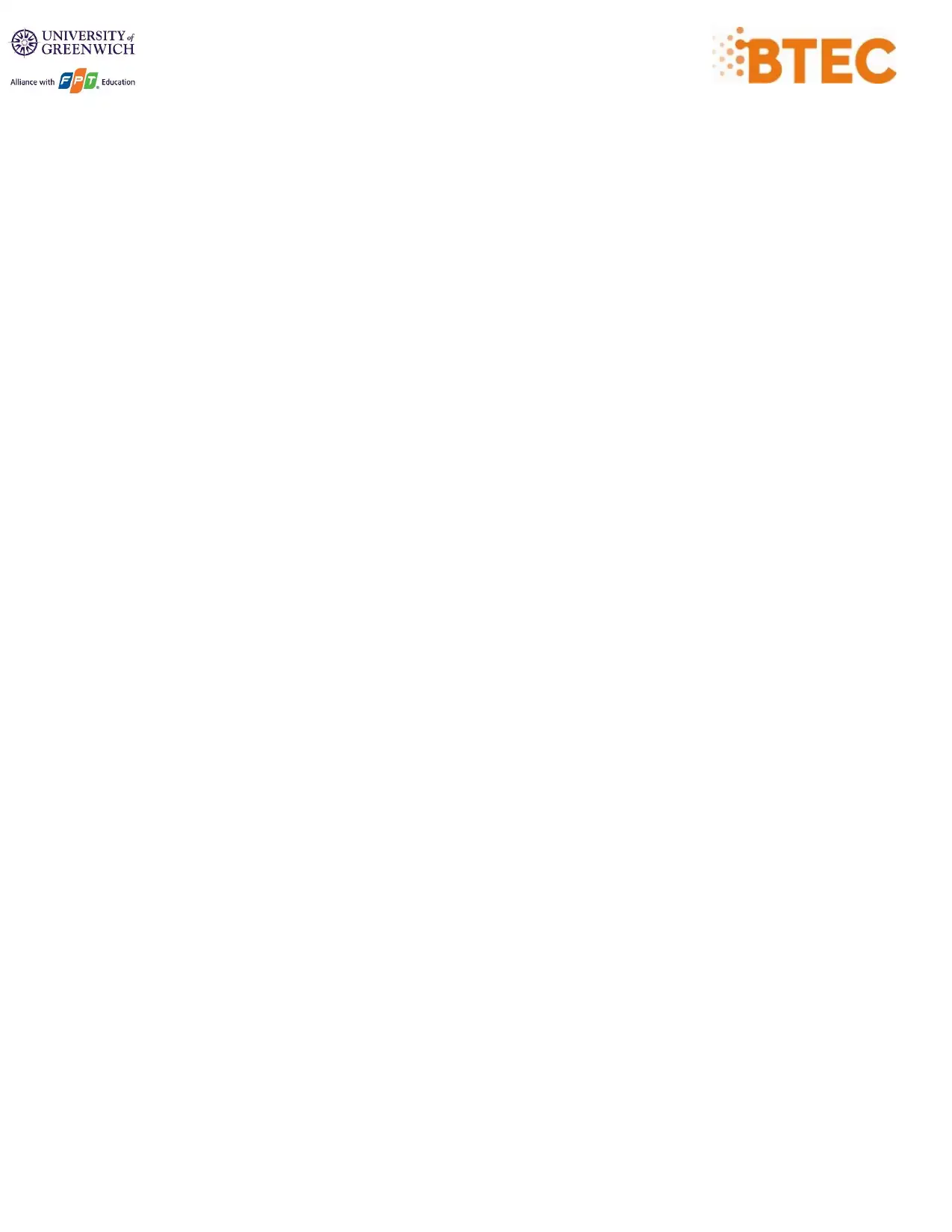
1 out of 36
Related Documents
Your All-in-One AI-Powered Toolkit for Academic Success.
+13062052269
info@desklib.com
Available 24*7 on WhatsApp / Email
![[object Object]](/_next/static/media/star-bottom.7253800d.svg)
Unlock your academic potential
© 2024 | Zucol Services PVT LTD | All rights reserved.





